Abstract
This paper conducts a tutorial review of the analytic theory of seven classes of fractional vibrations based on elementary functions. We discuss the classification of seven classes of fractional vibrations and introduce the problem statements. Then, the analytic theory of class VI fractional vibrators is given. The analytic theories of fractional vibrators from class I to class V and class VII are, respectively, represented. Furthermore, seven analytic expressions of frequency bandwidth of seven classes of fractional vibrators are newly introduced in this paper. Four analytic expressions of sinusoidal responses to fractional vibrators from class IV to VII by using elementary functions are also newly reported in this paper. The analytical expressions of responses (free, impulse, step, and sinusoidal) are first reported in this research. We dissert three applications of the analytic theory of fractional vibrations: (1) analytical expression of the forced response to a damped multi-fractional Euler–Bernoulli beam; (2) analytical expressions of power spectrum density (PSD) and cross-PSD responses to seven classes of fractional vibrators under the excitation with the Pierson and Moskowitz spectrum, which are newly introduced in this paper; and (3) a mathematical explanation of the Rayleigh damping assumption.
1. Introduction
When a system is with inertial force and restorative one, it may vibrate. Mass is the measure of inertia and stiffness is the measure of restoration. Let m and k be the mass and stiffness of a vibration system, respectively. Denote by x(t) displacement. Then, the inertial force is mx″(t) and restorative force is kx(t).
If a system vibrates with a certain dissipative force, we say that a vibration system has damping. Using the concept of viscous or linear damping, the damping force is cx′(t), where c is called viscous damping coefficient (damping for short). Thus, conventional linear vibration considers a second-order differential equation in the following form
where f(t) is the driven force and x0 and v0 are the initial conditions. In the above, the expression mx″(t) + cx′(t) + kx(t) = f(t) is called the equation of motion or motion equation of a linear vibration system. Among References [1,2,3,4,5,6,7,8,9,10,11,12,13,14,15,16,17,18,19,20,21,22,23,24,25,26,27,28,29,30,31,32,33,34,35,36,37,38,39,40,41,42,43,44,45,46,47,48,49,50,51,52,53,54,55,56,57,58,59,60,61,62,63,64,65,66,67,68,69,70,71,72,73,74,75,76,77,78,79,80,81,82,83,84,85,86,87,88,89,90,91,92,93,94,95,96,97,98,99,100,101,102,103,104,105,106,107,108,109,110,111,112,113,114,115,116,117,118,119,120,121,122,123,124,125,126,127,128,129,130,131,132,133], Harris [71] or Palley et al. [72] suffices for the preliminaries about the theory of conventional linear vibration.
The theory of linear vibration is mature. However, fractional vibration remains academic and interesting. By fractional vibration, we mean inertial force may be of fractional order α, that is, or damping force may be of fractional order β, that is, or restoration force may be of fractional order λ, i.e., (Li [24,25,26]). In this section, we describe the classification of fractional vibrations and brief the related results in Section 1.1, Section 1.2, Section 1.3, Section 1.4, Section 1.5, Section 1.6 and Section 1.7. Problem statements are presented in Section 1.8 and paper organization in Section 1.9.
1.1. Class I Fractional Vibration
Denote by m and k the primary mass and stiffness of a vibration system. Then, the simplest fractional vibration form is expressed by
The above vibration system has a fractional inertial force of order α, zero damping force in form, and standard restoration force. There are rich references about the research of (1), including Equation (3) of Duan [1], Equation (4.2) of Duan et al. [2], Equation (16) of Zurigat [3], Equation (1) of Blaszczyk and Ciesielski [4], Equation (10) of Blaszczyk et al. [5], Blaszczyk [6], Equation (3.1) of Al-rabtah et al. [7], Drozdov [8], Equation (9) of Stanislavsky [9], Equation (1) of Achar et al. [10], Equation (9) of [11], Equation (2) of [12], Equation (2) of Tofighi [13], Equation (1) of Ryabov and Puzenko [14], Equation (1) of Ahmad and Elwakil [15], Chapter 7 of Uchaikin [16], Tavazoei [17], Equation (36) of Sandev and Tomovski [18], Singh et al. [19], Equation (19b) of Rossikhin [20], Equation (1) of Pskhu and Rekhviashvili [21], Equation (1.2) of Aghchi et al. [22], and Equation (2.1) of Čermák and Kisela [23]. A common form of the solution of free response to (1) is given by
where Ea and b(z) is the generalized Mittag–Leffler function and is the primary damping free natural angular frequency. The solution x1(t) to (1) in the form of (2) is well known in the field (Achar et al. [10,11,12]; Chapter 7 of Uchaikin [16]). For facilitating discussions, we call a system that follows (1) a class I fractional vibrator.
Let h1(t) be the impulse of a class I fractional vibrator. A common expression of h1(t), by using the Mittag–Leffler function, is in the form
The impulse h1(t) in (3) is well known in the field (Chapter 7 of Uchaikin [16]).
Recently, Li [24,25,26] introduced a method to express the closed forms of x1(t) and h1(t) by using elementary functions. The analytic theory of class I fractional vibrators will be reviewed in Section 3.
1.2. Class II Fractional Vibration
Let m, c, and k be the primary mass, damping, and stiffness of a vibration system, respectively. The following fractional vibrator is widely studied
The above vibration system is with standard inertial force, fractional damping force of order β, and standard restoration force. There are rich references regarding (4), see, e.g., Equation (2) of Lin et al. [27], Equation (5) of Hermosillo-Arteaga et al. [28], Equation (1a) of Alkhaldi et al. [39], Equation (1) of Dai et al. [30], Equation (1) of Xu et al. [31], Equation (4) of He et al. [32], Equation (2) of Leung et al. [33], Equation (1) of Chen et al. [34], Equation (1) of Deü and Matignon [35], Equation (4) of Drăgănescu et al. [36], Equation (1) of Xie and Lin [37], Equation (1) of Ren et al. [38], Equation (1) of [39], Equation (8) of Yuan et al. [40], Equations (22) and (23) of Shitikova [41], Equation (1) of Lin et al. [42], Equation (1) of Naranjani et al. [43], Equation (1) of Duan and Zhang [44], Matteo et al. [45], Equation (44) of Tomovski and Sandev [46], Equation (2.4) of Zelenev et al. [47], Equation (3) of Rossikhin and Shitikova [48], Equation (2.2.2) of [49], Equation (26a) of [50], Equation (32) of Bagley and Torvik [51], Equation (18) of Spanos and Malara [52], Equation (1) of [53], Equation (1a) of Hu et al. [54], Equation (8) of Cao et al. [55], Equation (8) of [56], Equation (7) of Kaltenbacher and Schlintl [57], and Equation (1.1) of Pang et al. [58]. In order to facilitate discussion, we call a system that obeys (4) a class II fractional vibrator.
Using the Mittag–Leffler function, Pang et al. [58] proposed (5) as the general solution to (4)
Note that Li [24,25,26] recently introduced an analytical expression of x2(t) simply using elementary functions. We will review the analytic theory of class II fractional vibrators in Section 4.
1.3. Class III Fractional Vibration
When the motion equation of a system follows
it is called a class III fractional vibrator, for the purpose of facilitating discussion (Li [24]). The literature regarding (6) includes Gomez-Aguilar [59], Equation (10); Tian et al. [60]; Berman and Cederbaum [61]; Duan et al. [62], Equation (2); Mendiola-Fuentes et al. [63], Equation (4); Morales-Delgado et al. [64], Equation (16); Parovik [65], Equation (1); Ref. [66], Equation (4); and Sene and Aguilar [67], Equation (8). By using the Mittag–Leffler function (Berman and Cederbaum [61]) and specifically when 2β = α, the expression of the general solution to (6) is in the form
In (7),
In (8), is the primary damping ratio.
Let G3(t) be the unit step response to (6). Duan et al. [68] obtained (9) to express G3(t) for α being independent of β in series form
Recently, Li [24,25,26] addressed the analytical expression of the general solution to (6) when α is independent of β by using elementary functions. The analytic theory of class III fractional vibrators will be reviewed in Section 5.
1.4. Class IV Fractional Vibration
For facilitating discussion, a system is called a class IV fractional vibrator when its motion equation is in the form
where 0 ≤ λ < 1. The above vibration system is with fractional inertia force of order α, zero damping force in form, and fractional restoration force of order λ. Reports regarding (10) are rarely seen but in the author’s recent work [24,25]. We shall review the analytic theory of class IV fractional vibrators in Section 6.
1.5. Class V Fractional Vibration
We call a system a class V fractional vibrator when its motion equation is in the form
The literature regarding (11) is quite scarce. Duan [70] presents (12) as its solution for x50 = 1 and v50 = 1
We will review the analytic theory of class V fractional vibrators using elementary functions in Section 7.
1.6. Class VI Fractional Vibration
When the motion equation of a system follows
it is called a class VI fractional vibrator (Li [25,26], Li [69]). The literature regarding (13) is scarce, with only Li [25,26] and Li [69], which give the closed form of the analytical expression of x6(t) using elementary functions. We shall review the analytic theory of class I fractional vibrators in Section 2.
1.7. Class VII Fractional Vibration
A system is called a class VII fractional vibrator if its motion equation is in the form
Reports about (14) are scarce except for Li [69], which expresses the closed form of x7(t) using elementary functions. The analytic theory of class VII fractional vibrators will be reviewed in Section 8.
1.8. Problem Statements
We consider five main problems as follows.
- (1)
- From the perspective of vibration engineering, people are interested in its equivalent mass or damping or stiffness (Harris [71], Palley et al. [72]). However, analytical expressions of equivalent mass, damping, or stiffness with respect to fractional vibrations of classes I–VII are rarely reported. What they are is a problem.
- (2)
- Equivalent damping-free and damped natural angular frequencies play a key role in vibration engineering. However, their analytical expressions are seldom seen. What they are for class I–VII fractional vibrators is the second problem.
- (3)
- From an engineering point of view, the logarithmic decrement in a vibration system is essential. However, analytical expressions of equivalent logarithmic decrements in class I–VII fractional vibrators are rarely reported. What they are is a problem.
- (4)
- The quantity called the Q factor of a vibration system plays a role in engineering. Nonetheless, analytical expressions of Q factors for fractional vibrators of classes I–VII are rarely seen. What Q factors are for class I–VII fractional vibrators is a problem.
- (5)
- Let B0.707 be the frequency bandwidth of a vibration system. It is a crucial parameter in describing a vibration system. Nevertheless, analytical expressions of equivalent frequency bandwidths of fractional vibrators of classes I–VII are seldom seen. What they are is a problem
In order to find solutions to the above problems, we study seven classes of fractional vibrations with the focus on explicitly expressing equivalent mass or damping or stiffness. This tutorial review work based on Li [24,25,26,69] gives the solutions to all problems above. Since the solutions are expressed by using elementary functions, we use the term “analytic theory” in this research.
1.9. Paper Organization
In Section 2, we address the analytic theory of class VI fractional vibrations. We expound the analytic theories of fractional vibrations with classes I–V and VII in Section 3, Section 4, Section 5, Section 6, Section 7 and Section 8, respectively. As an application of fractional vibrations, we discuss the closed form of forced response to a multi-fractional damped Euler–Bernoulli beam in Section 9. In Section 10, we propose the analytical expressions of power spectrum density (PSD) and cross-PSD response to fractional vibrations driven by random processes with the Pierson and Moskowitz spectrum as an application case of fractional vibrations in Section 1, Section 2, Section 3, Section 4, Section 5, Section 6, Section 7 and Section 8 to fractionally random vibrations. In Section 11, we address a theory application of fractional vibrations to the mathematical explanation of the Rayleigh damping assumption. Finally, Section 12 gives a summary and the conclusions.
2. Analytic Theory of Class VI Fractional Vibrators
This section gives a tutorial regarding the analytic theory of class VI fractional vibrators in seven parts: (1) the analytical expression of frequency transfer function of class VI fractional vibrator in Theorem 1 in Section 2.1; (2) the equivalent motion equation of class VI vibration systems in Theorem 2 in Section 2.2; (3) the analytical expressions of equivalent parameters of class VI fractional vibrators in Section 2.3; (4) the analytical expressions of responses of class VI fractional vibrators in Theorems 3–6 in Section 2.4, where the sinusoidal response expression is newly introduced; (5) the analytical expression for the equivalent logarithmic decrement in class VI fractional vibrators in Theorem 7 in Section 2.5; (6) the analytical expression of the equivalent quality factor of class VI fractional vibrators in Theorem 8 in Section 2.6; (7) in addition, the analytical expression for the equivalent frequency bandwidth in class VI fractional vibrators is newly reported in Theorem 9 in Section 2.7.
2.1. Frequency Transfer Function of Class VI Fractional Vibrator
Theorem 1 (Frequency transfer function VI).
Let H6(ω) be the frequency transfer function of a class VI fractional vibrator [25,26]. Then,
Proof.
Denote by F(ω) the Fourier transform of f(t). Let X6(ω) be the Fourier transform of x6(t). With (13), performing the Fourier transform on the both sides of yields
From (16),
From (17), we see that (15) is true. The proof is finished. □
2.2. Equivalent Motion Equation of Class VI Fractional Vibrator
Theorem 2 (Equivalent motion equation VI).
The motion Equation (13) of class VI fractional vibrators is equivalently equal to
Proof.
Performing the Fourier transform on the both sides of the above equation yields
The above implies From (19), we see that (18) holds. This finishes the proof. □
2.3. Equivalent Parameters of Class VI Fractional Vibrator
Corollary 1 (Equivalent mass VI).
Let meq6 be the equivalent mass of class VI fractional vibrators [25,26]. Then,
Proof.
The right side of the above expression is the coefficient of in (18) and (20) holds. The proof is finished. □
Corollary 2 (Equivalent damping VI).
Denote by ceq6 the equivalent damping of class VI fractional vibrators [25,26]. Then,
Proof.
Because the right side of the above expression is the coefficient of in (18), it is an equivalent damping coefficient of class VI fractional vibrators expressed by (13). Thus, (21) is valid. The proof is finished. □
Corollary 3 (Equivalent stiffness VI).
Let keq6 be the equivalent stiffness of class VI fractional vibrators [25,26]. Then,
Proof.
Since the right side of the above expression is the coefficient of x6(t) in (18), we see that (22) is valid. The proof ends. □
Using meq6, ceq6, and keq6 to rewrite (18) produces the equivalent motion equation VI in the form
Corollary 4 (Equivalent damping ratio VI).
Denote by ζeq6 the equivalent damping ratio for class VI fractional vibrators [25,26]. Define it by
Then,
Proof.
Substituting meq6, ceq6, and keq6 into (24) results in (25). This finishes the proof. □
Note that ζeq6 > 1 is trivial in vibrations. Thus, we default |ζeq6| ≤ 1 in what follows.
Corollary 5 (Equivalent damping free natural angular frequency VI).
Denote by ωeqn6 the equivalent damping free natural angular frequency of class VI fractional vibrators [25,26]. Define it by
Then,
Proof.
Substituting meq6 and keq6 into (26) produces (27). The proof ends. □
Corollary 6 (Equivalent damped natural angular frequency VI).
Let ωeqd6 be the equivalent damped natural angular frequency of class VI fractional vibrators [25,26]. Define
Then,
Proof.
Substituting ωeqn6 and ζeq6 into (28) results in (29). The proof is finished. □
Corollary 7 (Equivalent frequency ratio VI).
Let γeq6 be the equivalent frequency ratio of class VI fractional vibrators [25,26]. Define it by
Then,
where
Proof.
Substituting ωeqn6 into (30) yields (31). The proof is finished. □
2.4. Responses of Class VI Fractional Vibrator
By using meq61, ζeq6, and ωeqn6, we rewrite (23) by (32) below
Theorem 3 (Free response VI).
Let x6(t) be the free response of a class VI fractional vibrator [25,26]. It is the solution to the following fractional differential equation
Then,
Proof.
The solution to (33) is equal to the solution to the following differential equation
From (35), we have (34). This completes the proof. □
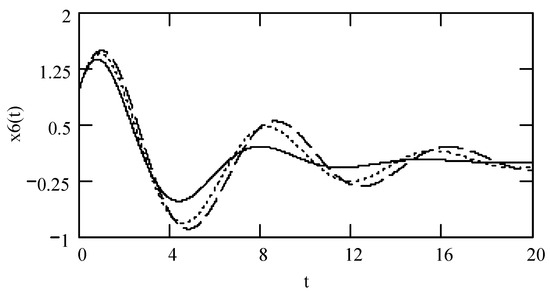
Figure 1.
Plots of x6(t) for ω = 1.3, m = 1, c = 0.2, and k = 1 when (α, β, λ) = (1.9, 1.9, 0.3) (solid line), (2.1, 1.8, 0.4) (dotted line), and (2.2, 1.7, 0.5) (dashed line).
Theorem 4 (Impulse response VI).
Let h6(t) be the impulse response of a class VI fractional vibrator [25,26]. It is the solution to the fractional differential equation given by
with zero initial conditions. Then,
Proof.
The solution to (36) is equivalent to the one in the following differential equation
Equation (38) implies that (37) holds. The proof is finished. □
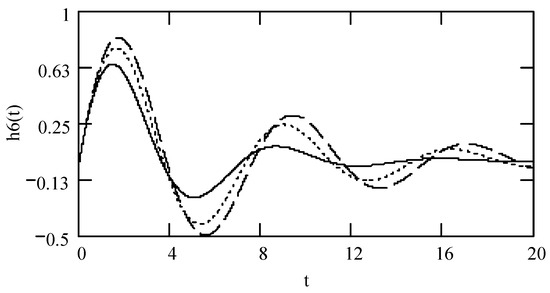
Figure 2.
Plots of h6(t) for ω = 1.3, m = 1, c = 0.2, and k = 1 when (α, β, λ) = (1.9, 1.9, 0.3) (solid line), (2.1, 1.8, 0.4) (dotted line), and (2.2, 1.7, 0.5) (dashed line).
Theorem 5 (Step response VI).
Let g6(t) be the unit step response of a class VI fractional vibrator [25,26]. It is the solution to (39) below
with zero initial conditions. Then,
where
Proof.
The solution to (39) is equal to the one in the following differential equation
From (42), we see that (40) with (41) is sound. This finishes the proof. □
The step response g6(t) can also be attained from (43) in the form
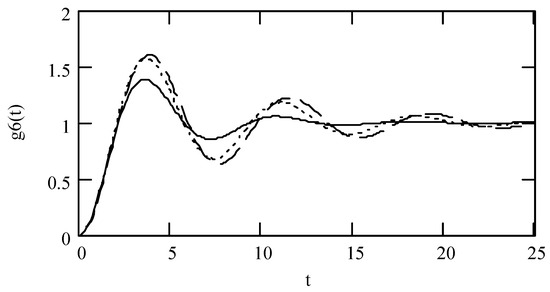
Figure 3.
Plots of g6(t) for ω = 1.3, m = 1, c = 0.2, and k = 1 when (α, β, λ) = (1.9, 1.9, 0.3) (solid line), (2.1, 1.8, 0.4) (dotted line), and (2.2, 1.7, 0.5) (dashed line).
Theorem 6 (Sinusoidal response VI).
Denote by x6zs(t) the sinusoidal response of a class VI fractional vibrator. It results from
Then,
Proof.
The solution to (44) is equal to the solution to (46) below
From (46), we see that (45) holds. This finishes the proof. □
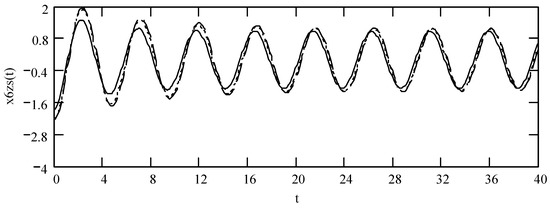
Figure 4.
Plots of x6zs(t) for ω = 1.3, m = 1, c = 0.2, and k = 1 when (α, β, λ) = (1.9, 1.9, 0.3) (solid line), (2.1, 1.8, 0.4) (dotted line), and (2.2, 1.7, 0.5) (dashed line).
2.5. Equivalent Logarithmic Decrement in Class VI Fractional Vibrators
Theorem 7 (Equivalent logarithmic decrement VI).
Let ti and ti+1 be two successive time points of the free response x6(t), where x6(t) reaches its successive peak values of x6(ti) and x6(ti+1), respectively. Let Δeq6 be the equivalent logarithmic decrement in x6(t) [25,26]. Then,
Proof.
With the free response x6(t), we have
Substituting ζeq6 into (48) results in (47). Thus, Theorem 7 holds. This finishes the proof. □
2.6. Quality Factor of Class VI Fractional Vibrators
Denote by Qeq6 the equivalent Q factor of class VI fractional vibrators. Equation (32) is the equivalent motion equation of class VI fractional vibrators, that is, in the standard form of conventional vibration systems. Hence, we define
Theorem 8 (Equivalent Q factor VI).
The quantity Qeq6 is given by
Proof.
Substituting ζeq6 into (49) yields (50) [25,26]. The proof ends. □
2.7. Equivalent Frequency Bandwidth of Class VI Fractional Vibrators
Let Beq6,0.707 be the equivalent frequency bandwidth of class VI fractional vibrators. Due to (32) being in the standard form of conventional vibration systems, we define
Theorem 9 (Equivalent frequency bandwidth VI).
The quantity Beq6,0.707 is given by
Proof.
Substituting ωeqn6 and Qeq6 into (51) results in (52). The proof ends. □
2.8. More about Frequency Transfer Function of Class VI Fractional Vibrations
By using γeq6, ζeq6 and keq6 [25,26], we have
In a polar system, we express (53) by H6(ω) = |H6(ω)|exp[−φ6(ω)], where
Equation (54) designates |H6(ω)|. Equation (55) below gives the phase of H6(ω)
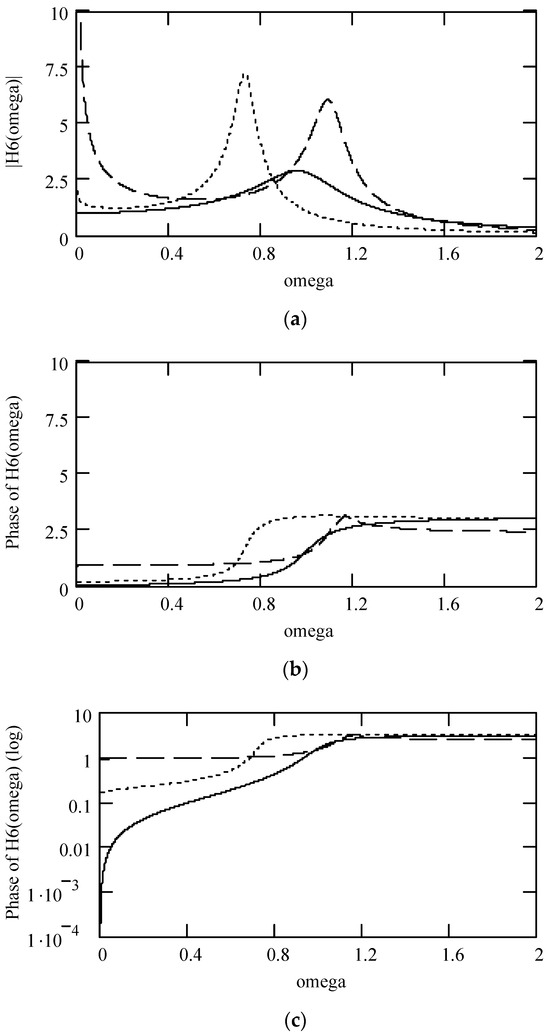
Figure 5.
Plots of |H6(ω)| and φ6(ω) for m = 1, c = 0.2, and k = 1 when (α, β, λ) = (1.9, 1.0, 0) (solid line), (2.1, 0.8, 0.1) (dotted line), and (2.5, 0.5, 0.6) (dashed line). (a) |H6(ω)|; (b) φ6(ω); (c) logφ6(ω).
3. Representing Analytic Theory of Class I Fractional Vibrators
This section addresses a tutorial with respect to the analytic theory of class I fractional vibrators in seven aspects as follows. (1) The analytical expression of frequency transfer function of class I fractional vibrators in Theorem 10 in Section 3.1. (2) The equivalent motion equation of class I fractional vibrators in Theorem 11 in Section 3.2. (3) The analytical expressions for the equivalent parameters of class I fractional vibrators in Section 3.3. (4) The analytical expressions of responses of class I fractional vibrators in Theorems 12–15 in Section 3.4. (5) The analytical expression of the equivalent logarithmic decrement in class I fractional vibrators in Theorem 16 in Section 3.5. (6) The analytical expression of the equivalent quality factor of class I fractional vibrators in Theorem 17 in Section 3.6. (7) Additionally, we put forward the analytical expression of the equivalent frequency bandwidth for class I fractional vibrators in Theorem 18 in Section 3.7.
3.1. Frequency Transfer Function of Class I Fractional Vibrator
Theorem 10 (Frequency transfer function I).
Denote by H1(ω) the frequency transfer function of a class I fractional vibrator. Then,
Proof.
A class I fractional vibrator is a special case of a class VI one when c = 0 and λ = 0. Thus, doing the operation of (57)
yields (56). The proof is finished. □
3.2. Equivalent Motion Equation of Class I Fractional Vibrator
Theorem 11 (Equivalent motion equation I).
The motion Equation (1) of a class I fractional vibrators is equivalently expressed by
Proof.
Because a class I fractional vibrator is a special case of a class VI one when c = 0 and λ = 0, replacing c and λ in (18) with 0 produces (58). This finishes the proof. □
3.3. Equivalent Parameters of Class I Fractional Vibrator
Corollary 8 (Equivalent mass I).
Let meq1 be the equivalent mass of class I fractional vibrators. Then,
Proof.
The right side of the above expression is the coefficient of in (58). Thus, (59) is true. This finishes the proof. □
Corollary 9 (Equivalent damping I).
Let ceq1 be the equivalent damping of class I fractional vibrators. Then,
Proof.
Because the right side of the above expression is the coefficient of in (58), (60) is true. The proof is finished. □
Corollary 10 (Equivalent stiffness I).
Let keq1 be the equivalent stiffness of class I fractional vibrators. Then,
keq1= k.
Proof.
Since the right side of the above expression is the coefficient of x1(t) in (58), (61) is true. The proof ends. □
Using meq1, ceq1, and keq1 to rewrite (58) yields the equivalent motion equation I in the form of (62) below
Corollary 11 (Equivalent damping ratio I).
Let ζeq1 be the equivalent damping ratio for a class I fractional vibrator. It is defined by (63) below
Then,
Proof.
Substituting c = 0 and λ = 0 in (25) regarding ζeq6 yields (64). This finishes the proof. □
Due to ζeq1 > 1 being trivial in vibrations, we default |ζeq1| ≤ 1 in what follows.
Corollary 12 (Equivalent damping free natural angular frequency I).
Let ωeqn1 be the equivalent damping free natural angular frequency of class I fractional vibrators. Define it by (65) below
Then,
Proof.
Substituting c = 0 and λ = 0 in (27) with respect to ωeqn6 produces (66). The proof ends. □
Corollary 13 (Equivalent damped natural angular frequency I).
Let ωeqd1 be the equivalent damped natural angular frequency of class I fractional vibrators. Define
Then,
Proof.
Substituting ωeqn1 and ζeq1 into (67) results in (68). The proof is finished. □
Corollary 14 (Equivalent frequency ratio I).
Denote by γeq1 the equivalent frequency ratio of class I fractional vibrators. Define it by
Then,
Proof.
Substituting ωeqn1 into (69) produces (70). This finishes the proof. □
3.4. Responses of Class I Fractional Vibrator
By using meq1, ζeq1, and ωeqn1, we rewrite the equivalent motion equation of a class I fractional vibrator by (71) below
Theorem 12 (Free response I).
Denote by x1(t) the free response of a class I fractional vibrator. It is the solution to the following fractional differential equation
Then,
Proof.
The solution to (72) is equal to the solution to the following differential equation of (74)
Then, (73) holds. This completes the proof. □
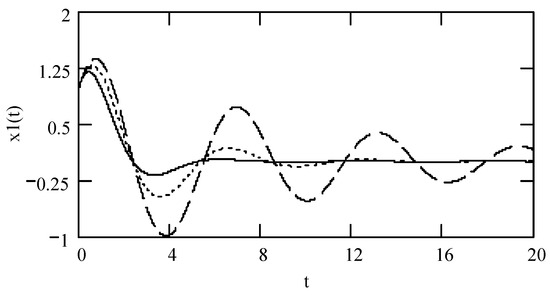
Figure 6.
Plots of x1(t) for ω = 1.3, m = 1, and k = 1 when α = 1.5 (solid line), 1.7 (dotted line), and 1.9 (dashed line).
Theorem 13 (Impulse response I).
Denote by h1(t) the impulse response of a class I fractional vibrator. It is the solution to the fractional differential equation given by
with zero initial conditions. Then,
Proof.
The solution to (75) is equivalent to the one in differential Equation (77)
Hence, (76) is true. The proof ends. □
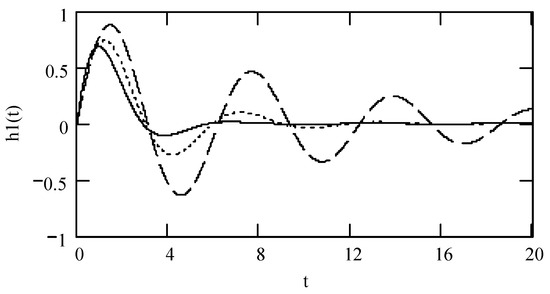
Figure 7.
Plots of h1(t) for ω = 1.3, m = 1, and k = 1 when α = 1.5 (solid line), 1.7 (dotted line), and 1.9 (dashed line).
Theorem 14 (Step response I).
Denote by g1(t) the unit step response of a class I fractional vibrator. It is the solution to the following equation
with zero initial conditions. Then,
where
Proof.
The solution to (78) is equal to the one to differential Equation (81)
Thus, (79) with (80) is true. This finishes the proof. □
The step response g1(t) can also be attained from (82) below
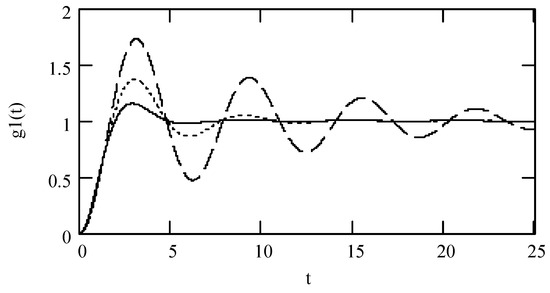
Figure 8.
Plots of g1(t) for ω = 1.3, m = 1, and k = 1 when α = 1.5 (solid line), 1.7 (dotted line), and 1.9 (dashed line).
Theorem 15 (Sinusoidal response I).
Let x1zs(t) be the sinusoidal response of a class I fractional vibrator. It results from
Then,
Proof.
The solution to (83) is equal to the one to (85) below
Hence, (84) results. This finishes the proof. □
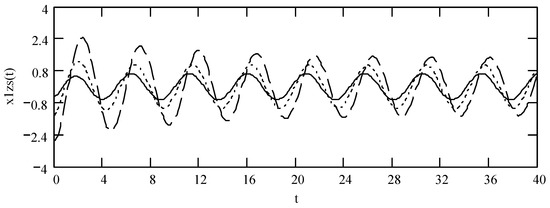
Figure 9.
Plots of x1zs(t) for ω = 1.3, m = 1, and k = 1 when α = 1.5 (solid line), 1.7 (dotted line), and 1.9 (dashed line).
3.5. Equivalent Logarithmic Decrement in Class I Fractional Vibrators
Theorem 16 (Equivalent logarithmic decrement I).
Let ti and ti+1 be two successive time points of the free response x1(t), where x1(t) reaches its successive peak values of x1(ti) and x1(ti+1), respectively. Let Δeq1 be the equivalent logarithmic decrement in x1(t). Then,
Proof.
Substituting c = 0 and λ = 0 in (47) for Δeq6 yields (86). This finishes the proof. □
3.6. Quality Factor of Class I Fractional Vibrators
Let Qeq1 be the equivalent Q factor of class I fractional vibrators. The equivalent motion equation of class I fractional vibrators is in the standard form of conventional vibration systems. Hence, we define
Theorem 17 (Equivalent Q factor I).
The quantity Qeq1 is given by
Proof.
Substituting ζeq1 into (87) produces (88). The proof ends. □
3.7. Equivalent Frequency Bandwidth of Class I Fractional Vibrators
Let Beq1,0.707 be the equivalent frequency bandwidth of class I fractional vibrators. Owing to the equivalent motion equation of class I fractional vibrators being in the standard form of conventional vibration systems, we define
Theorem 18 (Equivalent frequency bandwidth I).
The quantity Beq1,0.707 is expressed by
Proof.
Substituting ωeqn1 and Qeq1 into (89) yields (90). The proof is finished. □
3.8. More about Frequency Transfer Function of Class I Fractional Vibrators
By using γeq1, ζeq1, and keq1, we write H1(ω) as (91) below
When writing H1(ω) as |H1(ω)|exp[−φ1(ω)], we have |H1(ω)| in the form of (92)
The phase of H1(ω) is given by (93) in the form
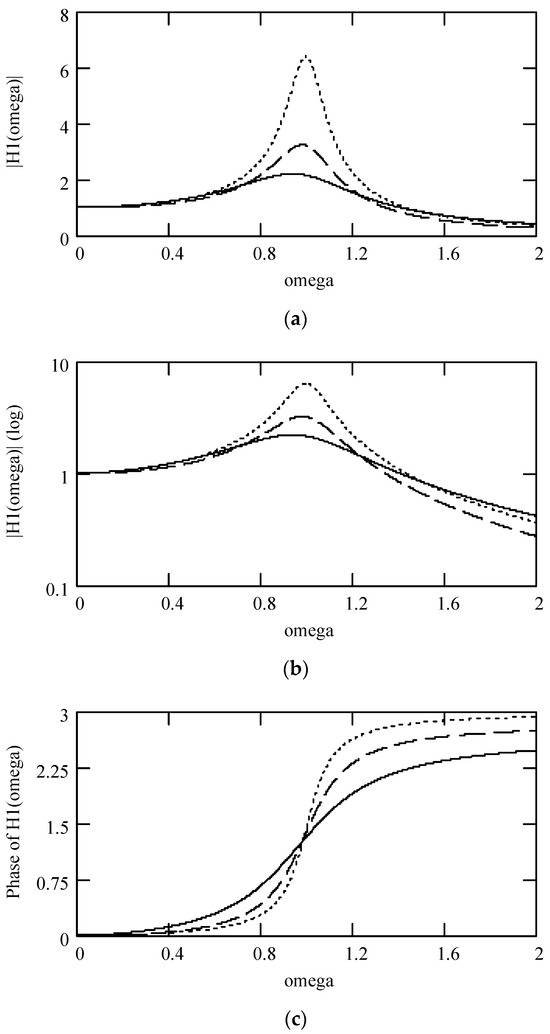
Figure 10.
Plots of |H1(ω)| and φ1(ω) for m = 1 and k = 1 when α = 1.7 (solid line), 1.9 (dotted line), and 2.2 (dashed line). (a) |H1(ω)|; (b) log|H1(ω)|; (c) φ1(ω).
4. Analytic Theory of Class II Fractional Vibrators
This section explains a tutorial regarding the analytic theory of class II fractional vibrators in seven parts: (1) the analytical expression of frequency transfer function of class II fractional vibrator in Theorem 19 in Section 4.1; (2) the equivalent motion equation of class II fractional vibrators in Theorem 20 in Section 4.2; (3) the analytical expressions for the equivalent parameters of class II fractional vibrators in Section 4.3; (4) the analytical expressions of class II fractional vibrator responses in Theorems 21–24 in Section 4.4; (5) the analytical expression of the equivalent logarithmic decrement in class II fractional vibrators in Theorem 25 in Section 4.5; (6) the analytical expression for the equivalent quality factor of class II fractional vibrators in Theorem 26 in Section 4.6; (7) additionally, we propose an analytical expression for the equivalent frequency bandwidth of class II fractional vibrators in Theorem 27 in Section 4.7.
4.1. Frequency Transfer Function of Class II Fractional Vibrator
Theorem 19 (Frequency transfer function II).
Let H2(ω) be the frequency transfer function of a class II fractional vibrator. Then,
Proof.
Since a class II fractional vibrator is a special case of a class VI fractional vibrator for α = 2 and λ = 0, doing the operation of (95)
produces (94). The proof ends. □
4.2. Equivalent Motion Equation of Class II Fractional Vibrator
Theorem 20 (Equivalent motion equation II).
The motion equation of class II fractional vibrators is equivalently expressed by
Proof.
Because a class II fractional vibrator is a special case of class VI one when α = 2 and λ = 0, substituting α = 2 and λ = 0 in (18) yields (96). The proof is finished. □
4.3. Equivalent Parameters of Class II Fractional Vibrator
Corollary 15 (Equivalent mass II).
Denote by meq2 the equivalent mass of a class II fractional vibrator. Then,
Proof.
The right side of the above expression is the coefficient of in (96). Thus, (97) holds. This finishes the proof. □
Corollary 16 (Equivalent damping II).
Denote by ceq2 the equivalent damping of a class II fractional vibrator. Then,
Proof.
Because the right side of the above expression is the coefficient of in (96), (98) holds. The proof ends. □
Corollary 17 (Equivalent stiffness II).
Let keq2 be the equivalent stiffness of a class II fractional vibrator. Then,
keq2 = k.
Proof.
As the right side of the above expression is the coefficient of x2(t) in (96), (99) is true. The proof ends. □
Using meq2, ceq2, and keq2 to rewrite (96) produces the equivalent motion equation II in the form (100) below
Corollary 18 (Equivalent damping ratio II).
Denote by ζeq2 the equivalent damping ratio for a class II fractional vibrator. Define it by the expression of (101)
Then,
Proof.
Substituting α = 2 and λ = 0 in ζeq6 results in (102). This finishes the proof. □
Due to ζeq2 > 1 being trivial in vibrations, we default |ζeq2| ≤ 1 in what follows.
Corollary 19 (Equivalent damping free natural angular frequency II).
Denote by ωeqn2 the equivalent damping free natural angular frequency of a class II fractional vibrator. Define it by the expression of (103)
Then,
Proof.
Substituting α = 2 and λ = 0 in ωeqn6 produces (104). The proof ends. □
Corollary 20 (Equivalent damped natural angular frequency II).
Denote by ωeqd2 the equivalent damped natural angular frequency of a class II fractional vibrator. Define
Then,
Proof.
Substituting ωeqn2 and ζeq2 into (105) yields (106). The proof ends. □
Corollary 21 (Equivalent frequency ratio II).
Let γeq2 be the equivalent frequency ratio of class II fractional vibrators. Define it by
Then,
Proof.
Substituting ωeqn2 into (107) results in (108). This finishes the proof. □
4.4. Responses of Class II Fractional Vibrator
By using meq2, ζeq2, and ωeqn2, we write the motion equation of a class II fractional vibrator by (109) below
Theorem 21 (Free response II).
Let x2(t) be the free response of a class II fractional vibrator. It is the solution to the following fractional differential equation
Then,
Proof.
The solution to (110) equals to the solution to differential Equation (112)
Then, (111) is true. This completes the proof. □
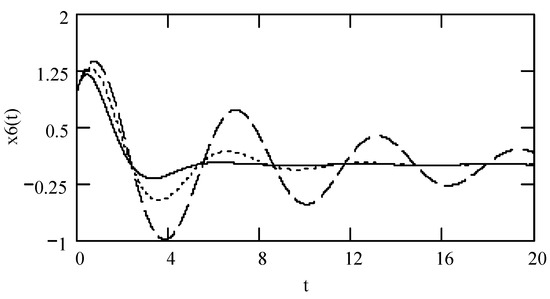
Figure 11.
Plots of x2(t) for ω = 1.3, m = 1, c = 0.2, and k = 1 when β = 0.9 (solid line), 1.4 (dotted line), and 1.9 (dashed line).
Theorem 22 (Impulse response II).
Let h2(t) be the impulse response of a class II fractional vibrator. It is the solution to the following fractional differential equation
with zero initial conditions. Then,
Proof.
The solution to (113) is equivalent to the one to (115)
Thus, (114) holds. The proof ends. □
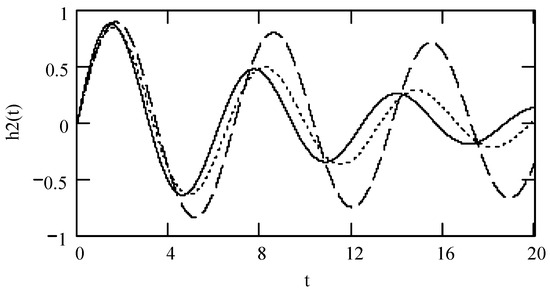
Figure 12.
Plots of h2(t) for ω = 1.3, m = 1, c = 0.2, and k = 1 when β = 0.9 (solid line), 1.4 (dotted line), and 1.9 (dashed line).
Theorem 23 (Step response II).
Denote by g2(t) the unit step response of a class II fractional vibrator. It is the solution to
with zero initial conditions. Then,
where
Proof.
The solution to (116) is equal to the one to (119)
Thus, (117) with (118) holds. This finishes the proof. □

Figure 13.
Plots of g2(t) for ω = 1.3, m = 1, c = 0.2, and k = 1 when β = 0.9 (solid line), 1.4 (dotted line), and 1.9 (dashed line).
Theorem 24 (Sinusoidal response II).
Denote by x2zs(t) the sinusoidal response of a class II fractional vibrator. It results from
Then,
Proof.
The solution to (120) is equal to the one to (122) below
Hence, (121) holds. This finishes the proof. □
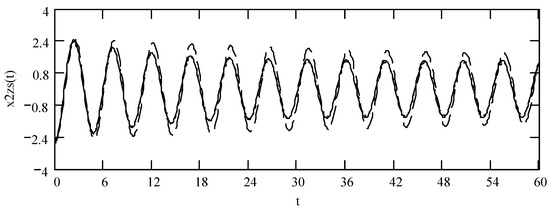
Figure 14.
Plots of x2zs(t) for ω = 1.3, m = 1, c = 0.2, and k = 1 when β = 0.9 (solid line), 1.4 (dotted line), and 1.9 (dashed line).
4.5. Equivalent Logarithmic Decrement in Class II Fractional Vibrators
Theorem 25 (Equivalent logarithmic decrement II).
Let ti and ti+1 be two successive time points of the free response x2(t), where x2(t) reaches its successive peak values of x2(ti) and x2(ti+1), respectively. Let Δeq2 be the equivalent logarithmic decrement in x2(t). Then,
Proof.
Substituting α = 2 and λ = 0 in Δeq6 yields Δeq2 in (123). This finishes the proof. □
4.6. Quality Factor of Class II Fractional Vibrators
Denote by Qeq2 the equivalent Q factor of class II fractional vibrators. The equivalent motion equation of class II fractional vibrators is in the standard form of conventional vibration systems. Hence, we define
Theorem 26 (Equivalent Q factor II).
The quantity Qeq2 is given by
Proof.
Substituting ζeq2 into (124) produces (125). The proof ends. □
4.7. Equivalent Frequency Bandwidth of Class II Fractional Vibrators
Let Beq2,0.707 be the equivalent frequency bandwidth of class II fractional vibrators. Owing to the equivalent motion equation of class II fractional vibrators being in the standard form of conventional vibration systems, we define
Theorem 27 (Equivalent frequency bandwidth II).
The quantity Beq2,0.707 is expressed by
Proof.
Substituting ωeqn2 and Qeq2 into (126) yields (127). The proof ends. □
4.8. More about Frequency Transfer Function of Class II Fractional Vibrators
By using γeq2, ζeq2, and keq2, we have H2(ω) in the form (128)
Writing H2(ω) = |H2(ω)|exp[−φ2(ω)] results in |H2(ω)| in the form of (129)
and φ2(ω) in the form of (130)
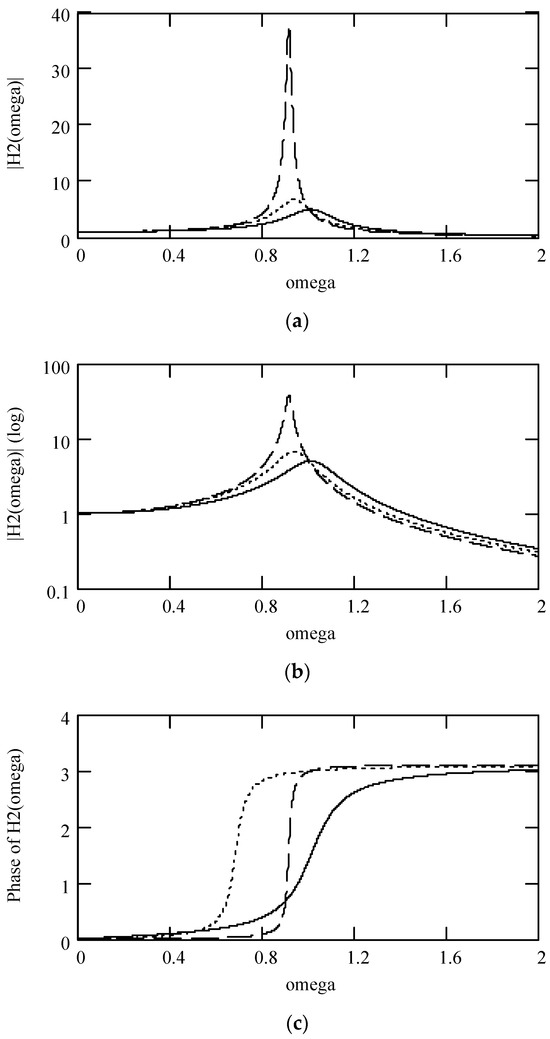
Figure 15.
Plots of |H2(ω)| and φ2(ω) for m = 1, c = 0.2, and k = 1 when β = 0.9 (solid line), 1.5 (dotted line), and 1.9 (dashed line). (a) |H2(ω)|; (b) log|H2(ω)|; (c). φ2(ω).
5. Representation of Analytic Theory of Class III Fractional Vibrators
We address a tutorial regarding the analytic theory of class III fractional vibrators from seven aspects: (1) the analytical expression of the frequency transfer function for a class III fractional vibrator in Theorem 28 in Section 5.1; (2) the equivalent motion equation of class III fractional vibrators in Theorem 29 in Section 5.2; (3) the analytical expressions for the equivalent parameters of class III fractional vibrators in Section 5.3; (4) the analytical expressions of responses of class III fractional vibrators in Theorems 30–33 in Section 5.4; (5) the analytical expression of the equivalent logarithmic decrement in class III fractional vibrators in Theorem 34 in Section 5.5; (6) the analytical expression of the equivalent quality factor of class III fractional vibrators in Theorem 35 in Section 5.6; (7) moreover, we present an analytical expression for the equivalent frequency bandwidth of class III fractional vibrators in Theorem 36 in Section 5.7.
5.1. Frequency Transfer Function of Class III Fractional Vibrator
Theorem 28 (Frequency transfer function III).
Let H3(ω) be the frequency transfer function of a class III fractional vibrator. Then,
Proof.
Note that a class III fractional vibrator is a special case of a class VI fractional vibrator for λ = 0. Thus, doing yields (131). The proof is finished. □
5.2. Equivalent Motion Equation of Class III Fractional Vibrator
Theorem 29 (Equivalent motion equation III).
The motion equation of class III fractional vibrators is equivalently expressed by
Proof.
Because a class III fractional vibrator is a special case of a class VI one for λ = 0, replacing λ with 0 in (18) produces (132). The proof ends. □
5.3. Equivalent Parameters of Class III Fractional Vibrator
Corollary 22 (Equivalent mass III).
Let meq3 be the equivalent mass of class III fractional vibrators. Then,
Proof.
The right side of the above expression is the coefficient of in (132). Hence, (133) is true. The proof is finished. □
Corollary 23 (Equivalent damping III).
Denote by ceq3 the equivalent damping of class III fractional vibrators. Then,
Proof.
Because the right side of the above expression is the coefficient of in (132), (134) holds. The proof ends. □
Corollary 24 (Equivalent stiffness III).
Denote by keq3 the equivalent stiffness of class III fractional vibrators. Then,
keq3 = k.
Proof.
As the right side of the above expression is the coefficient of x3(t) in (132), (135) holds. The proof is finished. □
By using meq3, ceq3, and keq3, we write (132) by the expression of (136)
Corollary 25 (Equivalent damping ratio III).
Let ζeq3 be the equivalent damping ratio for a class III fractional vibrator. Define it by (137) in the form
Then,
Proof.
Substituting λ = 0 in ζeq6 produces (138). This finishes the proof. □
Owing to ζeq3 > 1 being trivial in vibrations, we default |ζeq3| ≤ 1 in what follows.
Corollary 26 (Equivalent damping free natural angular frequency III).
Let ωeqn3 be the equivalent damping free natural angular frequency of class III fractional vibrators. Define it by the expression of (139)
Then,
Proof.
Substituting λ = 0 in ωeqn6 yields (140). The proof ends. □
Corollary 27 (Equivalent damped natural angular frequency III).
Denote by ωeqd3 the equivalent damped natural angular frequency of class III fractional vibrators. Define it by (141) below
Then,
Proof.
Substituting ωeqn3 and ζeq3 into ωeqd3 results in (142). The proof ends. □
Corollary 28 (Equivalent frequency ratio III).
Denote by γeq3 the equivalent frequency ratio of class III fractional vibrators. Define it by
Then,
Proof.
Substituting ωeqn3 into (143) yields (144). This finishes the proof. □
5.4. Responses of Class III Fractional Vibrator
With meq3, ζeq3, and ωeqn3, we write the motion equation of a class III fractional vibrator by (145) in the form
Theorem 30 (Free response III).
Denote by x3(t) the free response of a class III fractional vibrator. It is the solution to the following fractional differential equation
Then,
Proof.
The solution to (146) is equal to the one to (148)
Then, (147) holds. This completes the proof. □
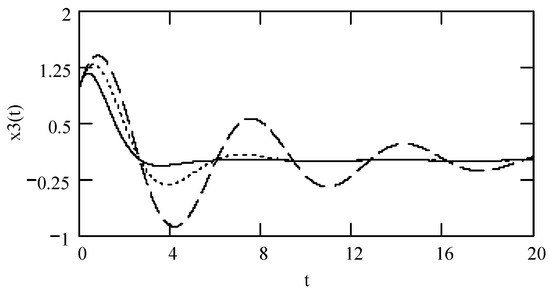
Figure 16.
Plots of x3(t) for ω = 1.3, m = 1, c = 0.2, and k = 1 when (α, β) = (1.3, 1.9) (solid line), (1.6, 1.8) (dotted line), and (1.9, 1.7) (dashed line).
Theorem 31 (Impulse response III).
Denote by h3(t) the impulse response of a class III fractional vibrator. It is the solution to the fractional differential equation given by
with zero initial conditions. Then,
Proof.
The solution to (149) is equivalent to the one to (151)
Therefore, (150) is true. The proof ends. □
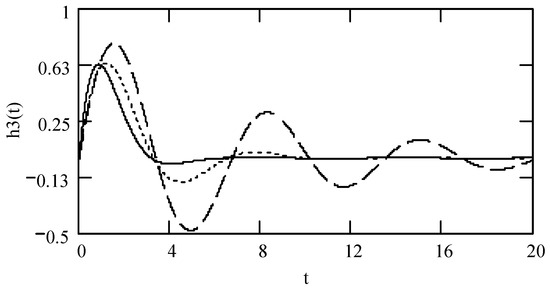
Figure 17.
Plots of h3(t) for ω = 1.3, m = 1, c = 0.2, and k = 1 when (α, β) = (1.3, 1.9) (solid line), (1.6, 1.8) (dotted line), and (1.9, 1.7) (dashed line).
Theorem 32 (Step response III).
Denote by g3(t) the unit step response of a class III fractional vibrator. It is the solution to (152)
with zero initial conditions. Then,
where
Proof.
Substituting λ = 0 into g6(t) yields g3(t) in (153) with (154). This finishes the proof. □
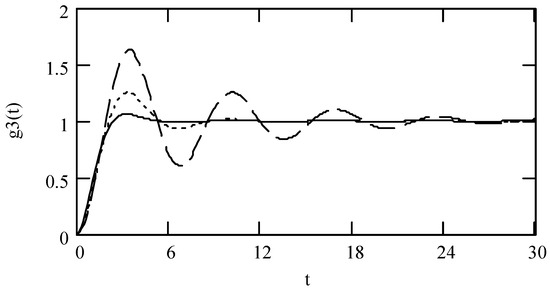
Figure 18.
Plots of g3(t) for ω = 1.3, m = 1, c = 0.2, and k = 1 when (α, β) = (1.3, 1.9) (solid line), (1.6, 1.8) (dotted line), and (1.9, 1.7) (dashed line).
Theorem 33 (Sinusoidal response III).
Denote by x3zs(t) the sinusoidal response of a class III fractional vibrator. It results from
Then,
Proof.
The solution to (155) is equal to the one to (157)
Hence, (156) holds. This finishes the proof. □
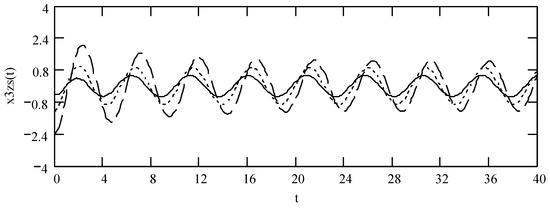
Figure 19.
Plots of x3zs(t) for ω = 1.3, m = 1, c = 0.2, and k = 1 when (α, β) = (1.3, 1.9) (solid line), (1.6, 1.8) (dotted line), and (1.9, 1.7) (dashed line).
5.5. Equivalent Logarithmic Decrement in Class III Fractional Vibrators
Theorem 34 (Equivalent logarithmic decrement III).
Let ti and ti+1 be two successive time points of the free response x3(t), where x3(t) reaches its successive peak values of x3(ti) and x3(ti+1), respectively. Let Δeq3 be the equivalent logarithmic decrement in x3(t). Then,
Proof.
Substituting λ = 0 into Δeq6 produces Δeq3 in (158). The proof ends. □
5.6. Quality Factor of Class III Fractional Vibrators
Denote by Qeq3 the equivalent Q factor of class III fractional vibrators. The equivalent motion equation of class III fractional vibrators is in the standard form of conventional vibration systems. Hence, we define
Theorem 35 (Equivalent Q factor III).
The quantity Qeq3 is given by
Proof.
Substituting ζeq3 into (159) yields (160). The proof is finished. □
5.7. Equivalent Frequency Bandwidth of Class III Fractional Vibrators
Let Beq3,0.707 be the equivalent frequency bandwidth of class III fractional vibrators. Owing to the equivalent motion equation of class III fractional vibrators being in the standard form of conventional vibration systems, we define
Theorem 36 (Equivalent frequency bandwidth III).
The quantity Beq3,0.707 is expressed by
Proof.
Substituting ωeqn3 and Qeq3 into (161) yields (162). The proof is finished. □
5.8. More about Frequency Transfer Function of Class III Fractional Vibrators
By using γeq3, ζeq3, and keq3, we have the expression of H3(ω) in the form (163)
When writing H3(ω) = |H3(ω)|exp[−φ3(ω)], we have the expression of |H3(ω)| in the form (164)
The phase of H3(ω) is given by (165) below
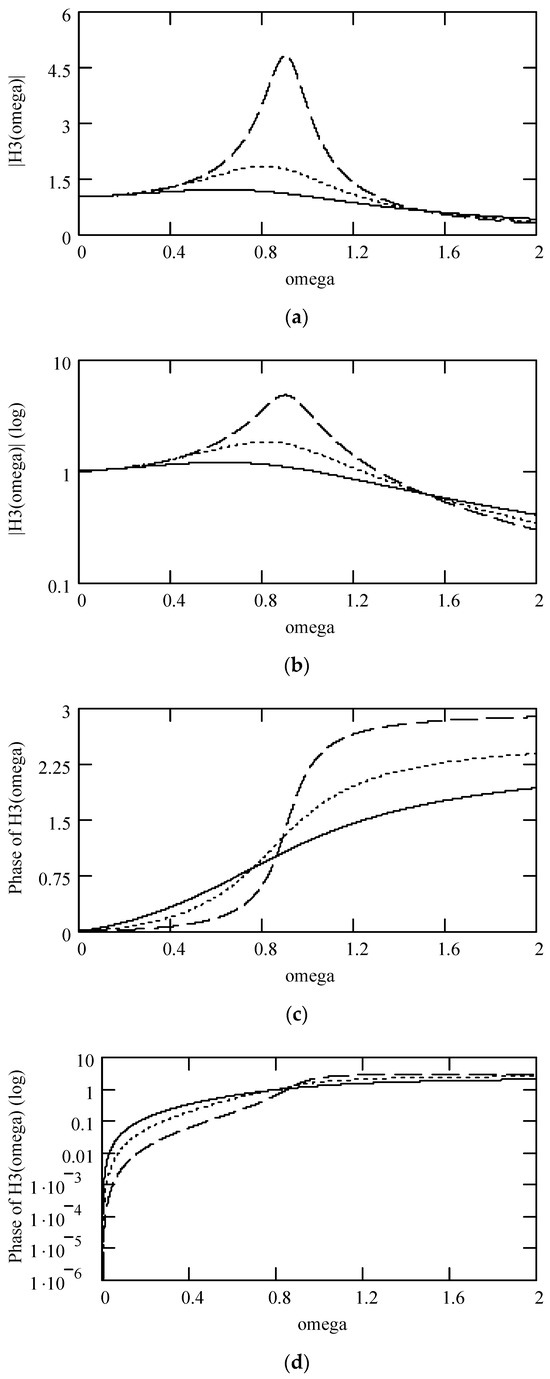
Figure 20.
Plots of |H3(ω)| and φ3(ω) for m = 1, c = 0.2, and k = 1 when (α, β) = (1.3, 1.9) (solid line), (1.6, 1.8) (dotted line), and (1.9, 1.7) (dashed line). (a) |H3(ω)|; (b) log|H3(ω)|; (c) φ3(ω); (d) logφ3(ω).
6. Analytic Theory of Class IV Fractional Vibrators
We discuss a tutorial with respect to the analytic theory of class IV fractional vibrators in seven parts: (1) the analytical expression of the frequency transfer function for a class IV fractional vibrator in Theorem 37 in Section 6.1; (2) the equivalent motion equation of class IV fractional vibrators in Theorem 38 in Section 6.2; (3) analytical expressions for the equivalent parameters of class IV fractional vibrators in Section 6.3; (4) the analytical expressions of responses of class IV fractional vibrators in Theorems 39–42 in Section 6.4, where the sinusoidal response expression is newly presented; (5) the analytical expression of the equivalent logarithmic decrement in class IV fractional vibrators in Theorem 43 in Section 6.5; (6) the analytical expression for the equivalent quality factor of class IV fractional vibrators in Theorem 44 in Section 6.6; (7) in addition, we bring forward an analytical expression for the equivalent frequency bandwidth of class IV fractional vibrators in Theorem 45 in Section 6.7.
6.1. Frequency Transfer Function of Class IV Fractional Vibrator
Theorem 37 (Frequency transfer function IV).
Let H4(ω) be the frequency transfer function of a class IV fractional vibrator. Then,
Proof.
Note that a class IV fractional vibrator is a special case of a class VI fractional vibrator for c = 0. Thus, substituting c = 0 into H6(ω) yields the above H4(ω) in (166). The proof is finished. □
6.2. Equivalent Motion Equation of Class IV Fractional Vibrator
Theorem 38 (Equivalent motion equation IV).
The motion equation of class IV fractional vibrators is equivalently expressed by
Proof.
As a class IV fractional vibrator is a special case of a class VI one for c = 0, replacing c with 0 in (18) yields (167). The proof is finished. □
6.3. Equivalent Parameters of Class IV Fractional Vibrator
Corollary 29 (Equivalent mass IV).
Denote by meq4 the equivalent mass of class IV fractional vibrators. Then,
Proof.
The right side of the above expression is the coefficient of in (167). Hence, (168) holds. The proof ends. □
Corollary 30 (Equivalent damping IV).
Let ceq4 be the equivalent damping of class IV fractional vibrators. Then,
Proof.
As the right side of the above expression is the coefficient of in (167), (169) holds. The proof is finished. □
Corollary 31 (Equivalent stiffness IV).
Denote by keq4 the equivalent stiffness of class IV fractional vibrators. Then,
Proof.
Because the right side of the above expression is the coefficient of x4(t) in (167), (170) holds. The proof ends. □
Using meq4, ceq4, and keq4 to write (167) yields (171) in the form
Corollary 32 (Equivalent damping ratio IV).
Denote by ζeq4 the equivalent damping ratio for a class IV fractional vibrator. Define it by (172) in the form
Then,
Proof.
Substituting c = 0 into ζeq6 produces the above ζeq4 in (173). This completes the proof. □
Because of ζeq4 > 1 being trivial in vibrations, |ζeq4| ≤ 1 is defaulted in what follows.
Corollary 33 (Equivalent damping free natural angular frequency IV).
Denote by ωeqn4 the equivalent damping free natural angular frequency of class IV fractional vibrators. Define it by (174) below
Then,
Proof.
Substituting c = 0 into ωeqn6 produces the above ωeqn4 in (175). The proof is finished. □
Corollary 34 (Equivalent damped natural angular frequency IV).
Let ωeqd4 be the equivalent damped natural angular frequency of class IV fractional vibrators. Define it by (176) below
Then,
Proof.
Substituting ωeqn4 and ζeq4 into ωeqd4 yields (177). The proof is finished. □
Corollary 35 (Equivalent frequency ratio IV).
Let γeq4 be the equivalent frequency ratio of class IV fractional vibrators. Define it by
Then,
Proof.
Substituting ωeqn4 into (178) produces (179). This completes the proof. □
6.4. Responses of Class IV Fractional Vibrator
Based on meq4, ζeq4, and ωeqn4, we can write the motion equation of a class IV fractional vibrator by (180) in the form
Theorem 39 (Free response IV).
Let x4(t) be the free response of a class IV fractional vibrator. It is the solution to the following fractional differential equation
Then,
Proof.
The solution to (181) is equal to the one to (183) below
Therefore, (182) is true. This completes the proof. □
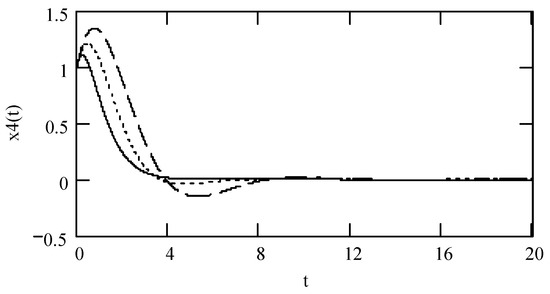
Figure 21.
Plots of x4(t) for ω = 1.3, m = 1, and k = 1 when (α, λ) = (1.3, 0.2) (solid line), (1.6, 0.4) (dotted line), and (1.9, 0.6) (dashed line).
Theorem 40 (Impulse response IV).
Denote by h4(t) the impulse response of a class IV fractional vibrator. It is the solution to the fractional differential equation given by
with zero initial conditions. Then,
Proof.
The solution to (184) can be taken as the one to (186) below
Thus, (185) holds. The proof ends. □
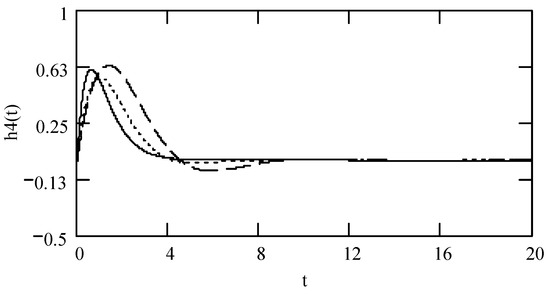
Figure 22.
Plots of h4(t) for ω = 1.3, m = 1, and k = 1 when (α, λ) = (1.3, 0.2) (solid line), (1.6, 0.4) (dotted line), and (1.9, 0.6) (dashed line).
Theorem 41 (Step response IV).
Let g4(t) be the unit step response of a class IV fractional vibrator. It is the solution to (187) in the form
with zero initial conditions. Then,
where
Proof.
Substituting c = 0 into g6(t) results in g4(t) in (188) with (189). This completes the proof. □
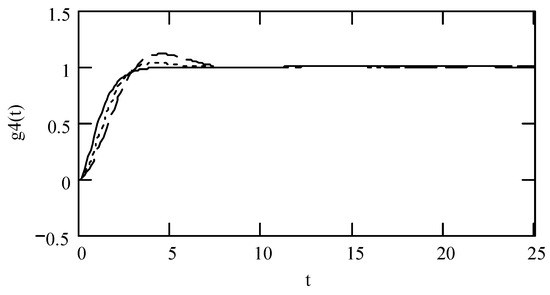
Figure 23.
Plots of g4(t) for ω = 1.3, m = 1, and k = 1 when (α, λ) = (1.3, 0.2) (solid line), (1.6, 0.4) (dotted line), and (1.9, 0.6) (dashed line).
Theorem 42 (Sinusoidal response IV).
Let x4zs(t) be the sinusoidal response of a class IV fractional vibrator. It results from
Then,
Proof.
The solution to (190) equals to the one to (192) below
Hence, (191) is true. This completes the proof. □
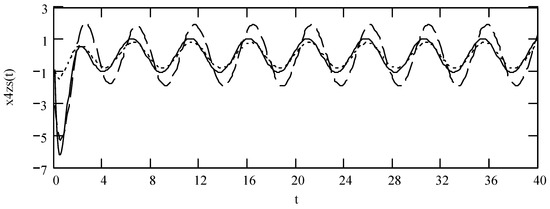
Figure 24.
Plots of x4zs(t) for ω = 1.3, m = 1, and k = 1 when (α, λ) = (1.3, 0.2) (solid line), (1.6, 0.5) (dotted line), and (1.9, 0.8) (dashed line).
6.5. Equivalent Logarithmic Decrement in Class IV Fractional Vibrators
Theorem 43 (Equivalent logarithmic decrement IV).
Let ti and ti+1 be two successive time points of the free response x4(t), where x4(t) reaches its successive peak values of x4(ti) and x4(ti+1), respectively. Let Δeq4 be the equivalent logarithmic decrement in x4(t). Then,
Proof.
Substituting c = 0 into Δeq6 yields the above Δeq4 in (193). The proof ends. □
6.6. Quality Factor of Class IV Fractional Vibrators
Let Qeq4 be the equivalent Q factor of class IV fractional vibrators. The equivalent motion equation of class IV fractional vibrators is in the standard form of conventional vibration systems. Hence, we define
Theorem 44 (Equivalent Q factor IV).
The quantity Qeq4 is given by
Proof.
Substituting ζeq4 into (194) yields (195). The proof ends. □
6.7. Equivalent Frequency Bandwidth of Class IV Fractional Vibrators
Let Beq4,0.707 be the equivalent frequency bandwidth of class IV fractional vibrators. As the equivalent motion equation of class IV fractional vibrators is in the standard form of conventional vibration systems, we define
Theorem 45 (Equivalent frequency bandwidth IV).
The quantity Beq4,0.707 is given by
Proof.
Substituting ωeqn4 and Qeq4 into (196) produces (197). The proof is finished. □
6.8. More about Frequency Transfer Function of Class IV Fractional Vibrators
By using γeq4, ζeq4, and keq4, we have H4(ω) in the form (198)
Since Re[H4(ω)] is in the form (199)
and Im[H4(ω)] is in the form (200)
we have H4(ω) expressed in the form of (201) below
Thus, the expression of |H4(ω)| is in the form of (202) below
Further, Arg[H4(ω)] is expressed by (203)
In engineering, we usually write H4(ω) in the form of (204)
Substituting γeq4, ζeq4, and keq4 into (202) yields |H4(ω)| in the form of (205) below
From the perspective of digital computations, we write φ4(ω) by (206)
H4(ω) = |H4(ω)|exp[−φ4(ω)].
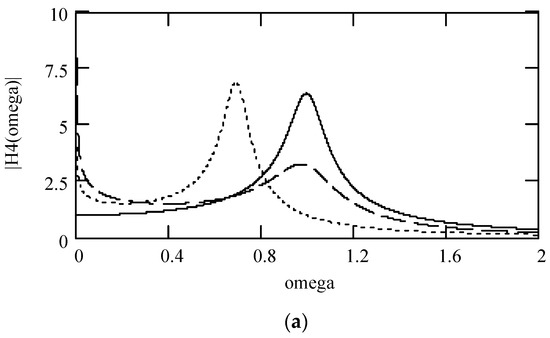
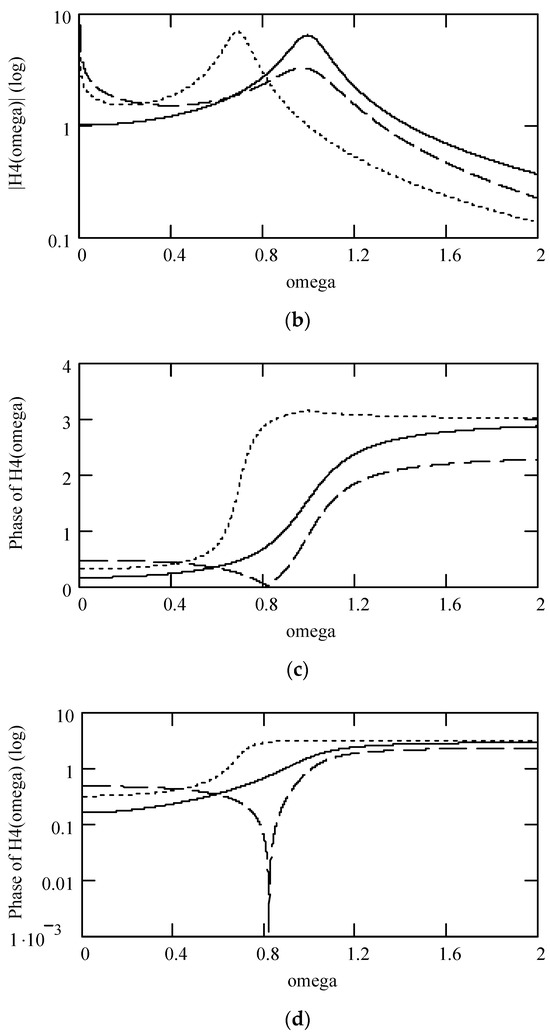
Figure 25.
Plots of |H4(ω)| and φ4(ω) for m = 1 and k = 1 when (α, λ) = (1.9, 0.1) (solid line), (2.1, 0.2) (dotted line), and (2.5, 0.3) (dashed line). (a) |H4(ω)|; (b) log|H4(ω)|; (c) φ4(ω); (d) logφ4(ω).
7. Analytic Theory of Class V Fractional Vibrators
We explain a tutorial with respect to the analytic theory of class V fractional vibrators from six aspects: (1) the analytical expression for the frequency transfer function of a class V fractional vibrator in Theorem 46 in Section 7.1; (2) the equivalent motion equation of class V fractional vibrators in Theorem 47 in Section 7.2; (3) analytical expressions for the equivalent parameters of class V fractional vibrators in Section 7.3; (4) the analytical expressions of responses of class V fractional vibrators in Theorems 48–51 in Section 7.4, where the sinusoidal response expression is newly proposed; (5) the analytical expression of the equivalent logarithmic decrement in class V fractional vibrators in Theorem 52 in Section 7.5; (6) the analytical expression for the equivalent quality factor of class V fractional vibrators in Theorem 53 in Section 7.6; (7) furthermore, we put forward an analytical expression for the equivalent frequency bandwidth in class V fractional vibrators in Theorem 54 in Section 7.7.
7.1. Frequency Transfer Function of Class V Fractional Vibrator
Theorem 46 (Frequency transfer function V).
Denote by H5(ω) the frequency transfer function of a class V fractional vibrator. Then,
Proof.
A class V fractional vibrator is a special case of a class VI fractional vibrator for α = 2 and c = 0. Therefore, substituting α = 2 and c = 0 into H6(ω) yields (207). The proof ends. □
7.2. Equivalent Motion Equation of Class V Fractional Vibrator
Theorem 47 (Equivalent motion equation V).
The motion equation of class V fractional vibrators is equivalently expressed by
Proof.
As a class V fractional vibrator is a special case of class VI one for α = 2 and c = 0, replacing α by 2 and c with 0 in (18) yields (208). This finishes the proof. □
7.3. Equivalent Parameters of Class V Fractional Vibrator
Corollary 36 (Equivalent mass V).
Let meq5 be the equivalent mass of class V fractional vibrators. Then,
meq5
= m.
Proof.
The right side of the above expression is the coefficient of in (208). Thus, (209) holds. The proof is finished. □
Corollary 37 (Equivalent damping V).
Denote by ceq5 the equivalent damping of class V fractional vibrators. Then,
Proof.
Because the right side of the above expression is the coefficient of in (208), (210) holds. The proof ends. □
Corollary 38 (Equivalent stiffness V).
Let keq5 be the equivalent stiffness of class V fractional vibrators. Then,
Proof.
As the right side of the above expression is the coefficient of x5(t) in (208), (211) holds. The proof ends. □
Using meq5, ceq5, and keq5 to write (208) produces (212) below
Corollary 39 (Equivalent damping ratio V).
Denote by ζeq5 the equivalent damping ratio for a class V fractional vibrator. Define it by (213) below
Then,
Proof.
Substituting α = 2 and c = 0 into ζeq6 produces the above ζeq5 in (214). The proof ends. □
Since ζeq5 > 1 is trivial in vibrations, |ζeq5| ≤ 1 is defaulted in what follows.
Corollary 40 (Equivalent damping free natural angular frequency V).
Let ωeqn5 be the equivalent damping free natural angular frequency of class V fractional vibrators. Define it by (215) below
Then,
Proof.
Substituting α = 2 and c = 0 into ωeqn6 produces the above ωeqn5 in (216). The proof ends. □
Corollary 41 (Equivalent damped natural angular frequency V).
Denote by ωeqd5 the equivalent damped natural angular frequency of class V fractional vibrators. Define
Then,
Proof.
Substituting ωeqn5 and ζeq5 into (217) results in (218). The proof ends. □
Corollary 42 (Equivalent frequency ratio V).
Let γeq5 be the equivalent frequency ratio of class V fractional vibrators. Define it by
Then,
Proof.
Substituting ωeqn5 into (219) produces (220). This finishes the proof. □
7.4. Responses of Class V Fractional Vibrator
Based on meq5, ζeq5, and ωeqn5, we can write the motion equation of a class V fractional vibrator in the form of (221)
Theorem 48 (Free response V).
Let x5(t) be the free response of a class V fractional vibrator. It is the solution to the following fractional differential equation
Then,
Proof.
The solution to (222) is equal to the one to (224) below
Thus, (223) holds. This finishes the proof. □
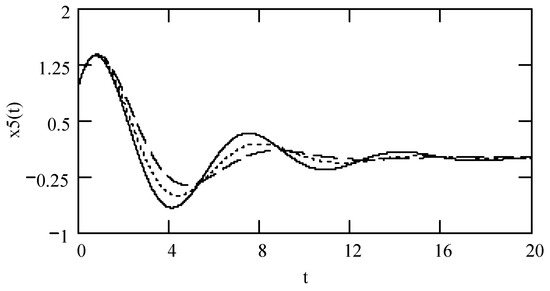
Figure 26.
Plots of x5(t) for ω = 1.3, m = 1, and k = 1 when λ = 0.3 (solid line), 0.4 (dot line), and 0.5 (dash line).
Theorem 49 (Impulse response V).
Let h5(t) be the impulse response of a class V fractional vibrator. It is the solution to the fractional differential equation given by
with zero initial conditions. Then,
Proof.
The solution to (225) can be taken as the one to (227) below
Thus, (226) holds. The proof ends. □
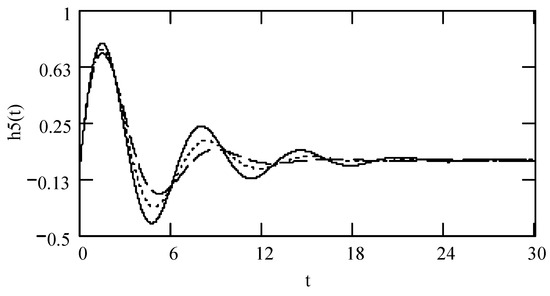
Figure 27.
Plots of h5(t) for ω = 1.3, m = 1, and k = 1 when λ = 0.3 (solid line), 0.4 (dotted line), and 0.5 (dashed line).
Theorem 50 (Step response V).
Let g5(t) be the unit step response of a class V fractional vibrator. It is the solution to (228)
with zero initial conditions. Then,
where
Proof.
Substituting α = 2 and c = 0 into g6(t) results in g5(t) in (229) with (230). This finishes the proof. □
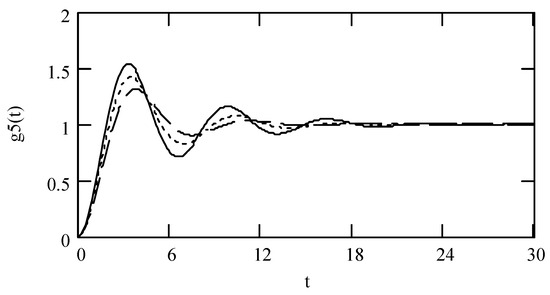
Figure 28.
Plots of g5(t) for ω = 1.3, m = 1, and k = 1 when λ = 0.3 (solid line), 0.4 (dotted line), and 0.5 (dashed line).
Theorem 51 (Sinusoidal response V).
Denote by x5zs(t) the sinusoidal response of a class V fractional vibrator. It results from
Then,
Proof.
The solution to (231) equals to the one to (233) below
Thus, (232) holds. This finishes the proof. □

Figure 29.
Plots of x5zs(t) for ω = 1.3, m = 1, and k = 1 when λ = 0.3 (solid line), 0.4 (dotted line), and 0.5 (dashed line).
7.5. Equivalent Logarithmic Decrement in Class V Fractional Vibrators
Theorem 52 (Equivalent logarithmic decrement V).
Let ti and ti+1 be two successive time points of the free response x5(t), where x5(t) reaches its successive peak values of x5(ti) and x5(ti+1), respectively. Let Δeq5 be the equivalent logarithmic decrement in x5(t). Then,
Proof.
Substituting α = 2 c = 0 into Δeq6 yields the above Δeq5 in (234). The proof is finished. □
7.6. Quality Factor of Class V Fractional Vibrators
Let Qeq5 be the equivalent Q factor of class V fractional vibrators. The equivalent motion equation of class V fractional vibrators is in the standard form of conventional vibration systems. Hence, we define
Theorem 53 (Equivalent Q factor V).
The quantity Qeq5 is given by
Proof.
Substituting ζeq5 into (235) yields (236). The proof ends. □
7.7. Equivalent Frequency Bandwidth of Class V Fractional Vibrators
Let Beq5,0.707 be the equivalent frequency bandwidth of class V fractional vibrators. As the equivalent motion equation of class V fractional vibrators is in the standard form of conventional vibration systems, we define
Theorem 54 (Equivalent frequency bandwidth V).
The quantity Beq5,0.707 is given by
Proof.
Substituting ωeqn5 and Qeq5 into (237) yields (238). The proof is finished. □
7.8. More about Frequency Transfer Function of Class V Fractional Vibrators
By using γeq5, ζeq5, and keq5, we have (239) to express H5(ω) by
Writing H5(ω) = |H5(ω)|exp[−φ5(ω)] results in (240) to express |H5(ω)| by
The phase of H5(ω) is given by (241) below
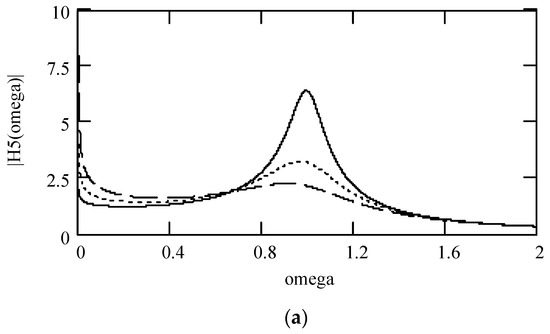
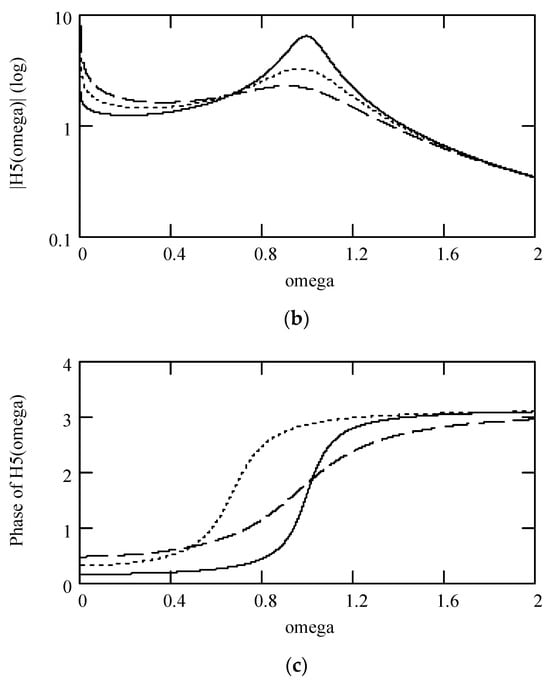
Figure 30.
Plots of |H5(ω)| and φ5(ω) for m = 1 and k = 1 when λ = 0.1 (solid line), 0.2 (dotted line), and 0.3 (dashed line). (a) |H5(ω)|; (b) log|H5(ω)|; (c) φ5(ω).
8. Analytic Theory of Class VII Fractional Vibrators
This section gives a tutorial with respect to the analytic theory of class VII fractional vibrators from seven aspects: (1) the analytical expression for the frequency transfer function of a class VII fractional vibrator in Theorem 55 in Section 8.1; (2) the equivalent motion equation of class VII fractional vibrators in Theorem 56 in Section 8.2; (3) analytical expressions for the equivalent parameters of class VII fractional vibrators in Section 8.3; (4) the analytical expressions of responses of class VII fractional vibrators in Theorems 57–60 in Section 8.4, where the sinusoidal response expression is first introduced; (5) the analytical expression of the equivalent logarithmic decrement in class VII fractional vibrators in Theorem 61 in Section 8.5; (6) the analytical expression for the equivalent quality factor of class VII fractional vibrators in Theorem 62 in Section 8.6; (7) moreover, we propose an analytical expression for the equivalent frequency bandwidth in class VII fractional vibrators in Theorem 63 in Section 8.7.
8.1. Frequency Transfer Function of Class VII Fractional Vibrator
Theorem 55 (Frequency transfer function VII).
Let H7(ω) be the frequency transfer function of a class VII fractional vibrator. Then,
Proof.
A class VII fractional vibrator is a special case of a class VI fractional vibrator in the case of α = 2. Thus, substituting α = 2 into H6(ω) yields the above H7(ω) in (242). The proof is finished. □
8.2. Equivalent Motion Equation of Class VII Fractional Vibrator
Theorem 56 (Equivalent motion equation VII).
The motion equation of class VII fractional vibrators is equivalently expressed by
Proof.
As a class VII fractional vibrator is a special case of a class VI one for α = 2, replacing α with 2 in (18) yields (243). This finishes the proof. □
8.3. Equivalent Parameters of Class VII Fractional Vibrator
Corollary 43 (Equivalent mass VII).
Denote by meq7 the equivalent mass of class VII fractional vibrators. Then,
Proof.
The right side of the above expression is the coefficient of in (243). Thus, (244) holds. The proof ends. □
Corollary 44 (Equivalent damping VII).
Let ceq7 be the equivalent damping of class VII fractional vibrators. Then,
Proof.
Because the right side of the above expression is the coefficient of in (243), (245) is true. This finishes the proof. □
Corollary 45 (Equivalent stiffness VII).
Denote by keq7 the equivalent stiffness of class VII fractional vibrators. Then,
Proof.
The right side of the above expression is the coefficient of x7(t) in (243); thus, (246) is true. The proof is finished. □
Using meq7, ceq7, and keq7 to rewrite (243) yields the equation of motion in (247) below
Corollary 46 (Equivalent damping ratio VII).
Let ζeq7 be the equivalent damping ratio for a class VII fractional vibrator. Define it by (248) below
Then,
Proof.
Substituting α = 2 into ζeq6 yields the above ζeq7 in (249). The proof ends. □
As ζeq7 > 1 is trivial in vibrations, |ζeq7| ≤ 1 is defaulted in what follows.
Corollary 47 (Equivalent damping free natural angular frequency VII).
Denote by ωeqn7 the equivalent damping free natural angular frequency of class VII fractional vibrators. Define it as (250)
Then,
Proof.
Substituting α = 2 into ωeqn6 produces the above ωeqn7 in (251) The proof ends. □
Corollary 48 (Equivalent damped natural angular frequency VII).
Let ωeqd7 be the equivalent damped natural angular frequency of class VII fractional vibrators. Define
Then,
Proof.
Substituting ωeqn7 and ζeq7 into (252) yields (253). The proof is finished. □
Corollary 49 (Equivalent frequency ratio VII).
Denote by γeq7 the equivalent frequency ratio of class VII fractional vibrators. Define it by
Then,
Proof.
Substituting ωeqn7 into (254) yields (255). The proof ends. □
8.4. Responses of Class VII Fractional Vibrator
Based on meq7, ζeq7, and ωeqn7, we write the motion equation of a class VII fractional vibrator by (256) below
Theorem 57 (Free response VII).
Denote by x7(t) the free response of a class VII fractional vibrator. It is the solution to the following fractional differential equation
Then,
Proof.
The solution to (257) equals to the one to (259) below
Hence, (258) is true. This completes the proof. □
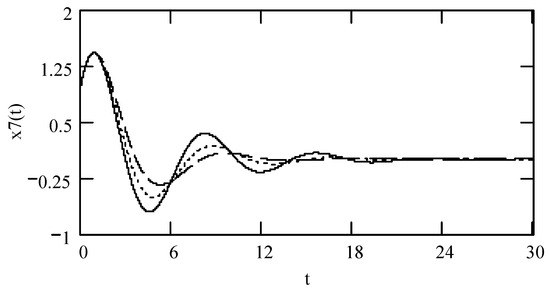
Figure 31.
Plots of x5(t) for ω = 1.3, m = 1, c = 0.2, and k = 1 when (β, λ) = (1.9, 0.3) (solid line), (1.8, 0.4) (dotted line), and (1.7, 0.5) (dashed line).
Theorem 58 (Impulse response VII).
Denote by h7(t) the impulse response of a class VII fractional vibrator. It is the solution to the fractional differential equation given by
with zero initial conditions. Then,
Proof.
The solution to (260) can be taken as the one to (262) below
Hence, (261) is true. The proof is finished. □
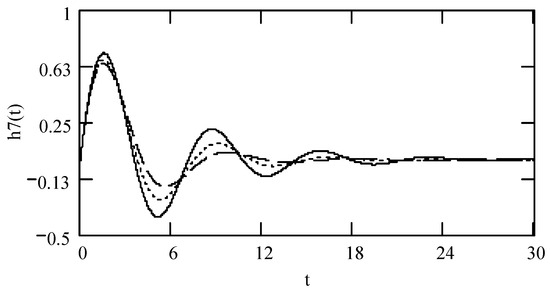
Figure 32.
Plots of h7(t) for ω = 1.3, m = 1, c = 0.2, and k = 1 when (β, λ) = (1.9, 0.3) (solid line), (1.8, 0.4) (dotted line), and (1.7, 0.5) (dashed line).
Theorem 59 (Step response VII).
Denote by g7(t) the unit step response of a class VII fractional vibrator. It is the solution to (263) below
with zero initial conditions. Then,
where
Proof.
Substituting α = 2 into g6(t) produces (264) with (265). This completes the proof. □
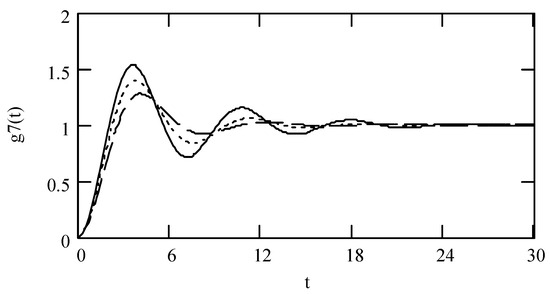
Figure 33.
Plots of g7(t) for ω = 1.3, m = 1, c = 0.2, and k = 1 when (β, λ) = (1.9, 0.3) (solid line), (1.8, 0.4) (dotted line), and (1.7, 0.5) (dashed line).
Theorem 60 (Sinusoidal response VII).
Let x7zs(t) be the sinusoidal response of a class VII fractional vibrator. It results from
Then,
Proof.
The solution to (266) is equal to the one to (268) below
Therefore, (267) is true. This completes the proof. □

Figure 34.
Plots of x7zs(t) for ω = 1.3, m = 1, c = 0.2, and k = 1 when (β, λ) = (1.9, 0.3) (solid line), (1.8, 0.4) (dotted line), and (1.7, 0.5) (dashed line).
8.5. Equivalent Logarithmic Decrement in Class VII Fractional Vibrators
Theorem 61 (Equivalent logarithmic decrement VII).
Let ti and ti+1 be two successive time points of the free response x7(t), where x7(t) reaches its successive peak values of x7(ti) and x5(ti+1), respectively. Let Δeq7 be the equivalent logarithmic decrement in x7(t). Then,
Proof.
Substituting α = 2 into Δeq6 produces the above Δeq7 in (269). The proof ends. □
8.6. Quality Factor of Class VII Fractional Vibrators
Let Qeq7 be the equivalent Q factor of class VII fractional vibrators. The equivalent motion equation of class VII fractional vibrators is in the standard form of conventional vibration systems. Hence, we define
Theorem 62 (Equivalent Q factor VII).
The quantity Qeq7 is given by
Proof.
Substituting ζeq7 into (270) produces (271). The proof is finished. □
8.7. Equivalent Frequency Bandwidth of Class VII Fractional Vibrators
Let Beq7,0.707 be the equivalent frequency bandwidth of class VII fractional vibrators. As the equivalent motion equation of class VII fractional vibrators is in the standard form of conventional vibration systems, we define
Theorem 63 (Equivalent frequency bandwidth VII).
The quantity Beq7,0.707 is given by
Proof.
Substituting ωeqn7 and Qeq7 into (272) yields (273). The proof is finished. □
8.8. More about Frequency Transfer Function of Class VII Fractional Vibrators
By using γeq7, ζeq7, and keq7, we have (274) to express H7(ω) in the form
Writing H7(ω) = |H7(ω)|exp[−φ7(ω)] yields (275) to express |H7(ω)| by
The phase of H5(ω) is given by (276) in the form
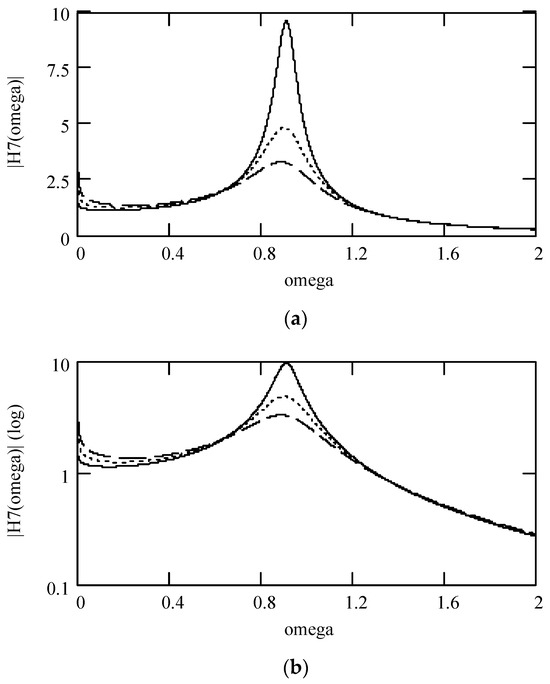
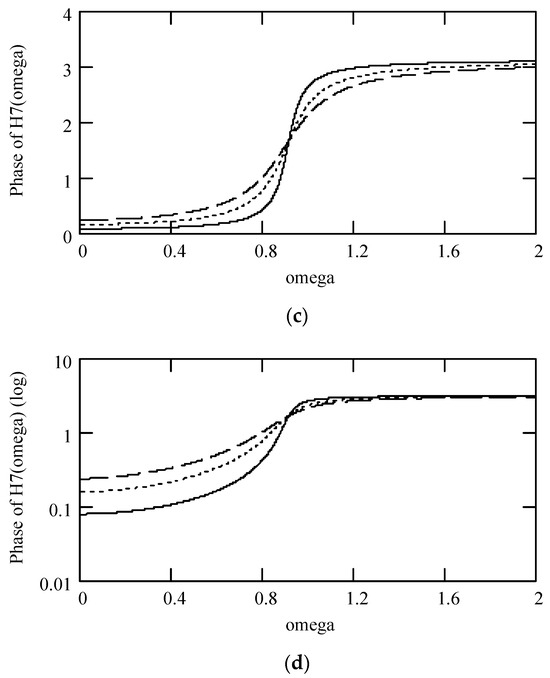
Figure 35.
Plots of |H7(ω)| and φ7(ω) for m = 1, c = 0.2, and k = 1 when (β, λ) = (1.9, 0.05) (solid line), (1.8, 0.10) (dotted line), and (1.7, 0.15) (dashed line). (a) |H7(ω)|; (b) log|H7(ω)|; (c) φ7(ω); (d) logφ7(ω).
9. Application: Analytical Expression of Forced Response to Multi-Fractional Damped Euler–Bernoulli Beam
The Euler–Bernoulli beam plays a role in structural vibrations (Harris [71]). This is particularly true in ship structural vibrations (Palley et al. [72]; Lewis [73]). There are references regarding applications of fractional calculus to the Euler–Bernoulli beam, see, e.g., Alkhaldi et al. [29], Spanos and Malara [53], Ouzizi et al. [74], Lewandowski and Baum [75], Nešić et al. [76], Rossikhin and Shitikova [77], and Freundlich [78,79,80]. However, the closed form expression of forced response to a multi-fractional damped Euler–Bernoulli beam is rarely reported. By multi-fractional, we mean that inertial, internal, and external damping forces are of fractional orders. As an application of the analytic theory of fractional vibrations previously discussed, in this section, we review the analytic theory of fractional Euler–Bernoulli beams in Li [26].
9.1. Multi-Fractional Damped Euler–Bernoulli Beam
Consider a uniform beam of length l. Let A be its cross-sectional area. Let ρ be its material density. Let I be its cross-sectional moment of inertia. Let E be its elastic modulus. Then, EI is its bending rigidity. Denote by cs and c internal and external damping, respectively. Denote by w(x, t) deflection. Let q(x, t) be driven force. Then, the motion equation of the conventional damped Euler–Bernoulli beam is expressed by
In (277), is external damping force, is internal damping force, and is inertia force (Palley et al. [72], Lewis [73]). The forced response to (277) under the Rayleigh damping assumption is known (Palley et al. [72], Lewis [73]).
The above equation takes into account the Voigt assumption on materials about internal damping. Following Li [26], we describe the closed form of the forced response to the multi-fractional damped Euler–Bernoulli beam in the form (278)
Precisely, the above stands for a beam with the fractional inertia force fractional internal damping force and fractional external damping force
9.2. Closed Form Forced Response
Using separation of variables, we write the response by w(x, t) = φ(x)p(t). Substituting it into (278) produces
In (279), pj(t) is the jth order coordinate and φj(t) is the jth order vibration mode (j = 1, 2, …). Using the orthogonality of vibration modes φm(x) on both sides of the above equation produces the following
where is the jth order generalized mass and Qj(t) the jth order generalized force.
Using (281) below
where is the jth order natural angular frequency; we rewrite (280) by
According to the Rayleigh damping assumption
where a is a coefficient with the unit of time since ρA is with the unit of mass, and
where b is a coefficient with the unit of frequency as E is with the unit [N/m].
c = ρAa,
cs = Eb,
Substituting (283) and (284) into (282) and taking into account the orthogonality of vibration modes, we have (285) below
Therefore, we have a multi-fractional differential equation with respect to pj(t) in the following form
where fj(t) is given by (287) in the form
According to the analytic theory of class VI fractional vibrators addressed in Section 2, (286) can be written by (288) in the form
As a matter of fact,
Let
For (289) and (290), F[Cj(t) − Dj(t)] = 0, where F is the operator of Fourier transform.
Denote by me-EBj the jth equivalent mass in (286) in the form (291)
Let ce-EBj be the jth equivalent damping in (286). It is given by (292) below
Using me-EBj and ce-EBj, we have (293) to express the coordinate motion equation by
Denote by ζe-EBj the jth equivalent damping ratio regarding (286). Define it by Then, it is given by (294) in the form
Let ωen-EBj be the jth equivalent damping free natural frequency regarding the system (286). It is given by (295) below
From a view of vibration engineering, we are only interested in (296)
Let ωend-EBj be the jth equivalent damped natural frequency regarding the system (286). Then, the expression of ωend-EBj is in the form (297) below
Therefore, we rewrite (293) by
Let hj(t) be the jth impulse response function of the system (298). Then, it is expressed by (299) in the form
Because of (300) below
the zero-state forced response to a multi-fractional damped Euler–Bernoulli beam is expressed by (301) in the form
9.3. Demonstration
Consider a free–free Euler–Bernoulli beam. Then, (302) below is the expression of φj(x)
where one uses the identity in the form (303) below
Let f(t) = u(t). Figure 36 demonstrates the plots of w1(x, t) = w1. Refer to [26] for more about applications and illustrations of fractional vibrations of class I-VII to beams.
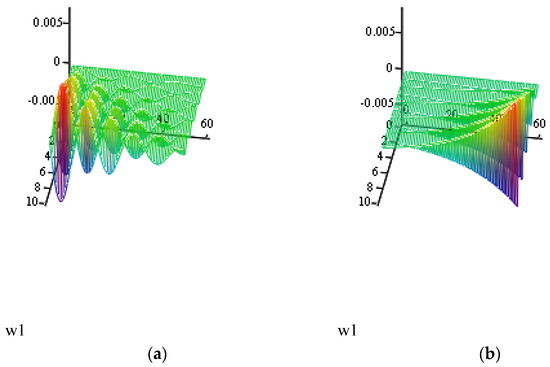
Figure 36.
Plots of w1(x, t) = w1 of a free-free damped Euler–Bernoulli beam when fj(t) = u(t) and l = 10 for ω = 0.0314, a = 1, b = 1, E = 1, x = 0, …, 10, and t = 0, …, 60. (a) w1 for α = 1.8; β = λ = 1.2. (b) w1 for α = 1.8, β = 1.2, and λ = 0.1.
10. Application: Seven Classes of Fractionally Random Vibrations Driven by P-M Spectrum
The contributions given in this chapter are the analytic expressions of the power spectrum density (PSD) responses and cross-PSD responses to fractional vibrators from class I to class VII under the excitation with Pierson and Moskowitz (P-M) spectrum using elementary functions. The present results show that fractional orders, namely, α, β, and λ, have considerable effects on responses when ocean surface waves pass through those fractional vibration systems.
10.1. Background
Since the early literature by Crandall and Mark [81] in random vibrations, the topic of random vibrations has remained of interest to researchers. The literature regarding random vibrations is rich, see, e.g., Harris [71], Palley et al. [72], Lewis [73], Nakagawa and Ringo [82], Lalanne [83], Nigam [84], Preumont [85,86], Soong and Grigoriu [87], Thomson and Dahleh [88], Lutes and Sarkani [89], Elishakoff and Lyon [90], Jensen [91], Rothbart and Brown [92], Simiu and Scanlan [93], Ra [94], Dhanak and Xiros [95], Findeisen [96], Mukhopadhyay [97], and Cheli [98], just to mention a few. However, reports regarding fractionally random vibrations are rarely seen except Li [69]. In Li [69], the author addresses the power spectrum density (PSD) and cross-PSD of the responses of seven classes of fractional vibrations previously discussed when driven signals are fractional Gaussian noise, fractional Brownian motion, fractional Ornstein–Uhlenbeck process, and the von Kármán process. Nonetheless, the closed expressions of the PSD and cross-PSD responses of seven classes of fractional vibrations driven by the P-M spectrum are rarely seen.
Note that the P-M spectrum is widely used in the field of ocean engineering and ship building for describing fully developed ocean surface waves (Jensen [91], Lewis [99], Massel [100], Chairabarti [101], Li [102], and the final report of the 23rd International Towing Tank Conference [103]). Therefore, as an application of the analytic theory of fractional vibrations previously addressed, in this section, we present the novel results with respect to the analytic expressions of PSD and cross-PSD responses of seven classes of fractional vibrations driven by process with the Pierson and Moskowitz (P-M) spectrum, expecting that the present results may be useful for further explore ship structural vibrations.
The rest of the section is organized as follows. The power spectrum density (PSD) responses and cross-PSD responses to seven classes of fractional vibration systems under the excitation of P-M spectrum are given in Section 10.2, Section 10.3, Section 10.4, Section 10.5, Section 10.6, Section 10.7 and Section 10.8, respectively. The summary is given in Section 10.9.
10.2. Responses of Class I Fractional Vibrators Driven by P-M Spectrum
10.2.1. Computations
For facilitating discussions, we write the motion equation of a class I fractional vibrator in (304)
where f(t) is the driven force with the P-M spectrum and x1(t) is the response.
Let Sff(ω) be the PSD of f(t). Suppose f(t) follows the P-M spectrum. Then,
In (305), α = 8.1 × 10−3, β = 0.74, g is the acceleration of gravity (m/s2), and V is wind speed (m/s) at an elevation of 19.5 m above the sea surface. The unit of S is m2·s. Figure 37 indicates a plot of Sff(ω) for V = 15.
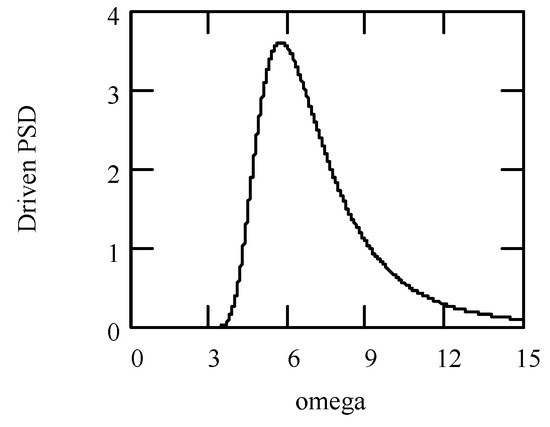
Figure 37.
Plot of P-M spectrum.
Theorem 64 (PSD response I).
Denote by Sxx1(ω) the PSD of the response x1(t). Equation (306) is its expression
Proof.
Equation (307) expresses the relationship between Sxx1(ω) and Sxx1(ω) in the form
Since
Sxx1(ω) = Sff(ω)|H1(ω)|2.
Theorem 64 holds. The proof is finished. □
Theorem 65 (Cross-PSD response I).
Let Sfx1(ω) be the cross-PSD between f(t) and x1(t). Equation (308) is its expression
Proof.
Note that
Equation (309) shows the relationship between Sfx1(ω) and Sff(ω)
Thus, Theorem 65 is sound. This finishes the proof. □
Sfx1(ω) = Sff(ω)H1(ω).
In the time domain, the autocorrelation function (ACF) response is given by (310)
and the cross-correlation response is expressed by (311)
rxx1(τ) = rff(τ)∗h1(τ)∗h1(−τ),
rfx1(τ) = rff(τ)∗h1(τ).
10.2.2. Effects of α on Responses
Figure 38 indicates some plots of |H1(ω)|2. Some plots of the PSD response Sxx1(ω) are shown in Figure 39.
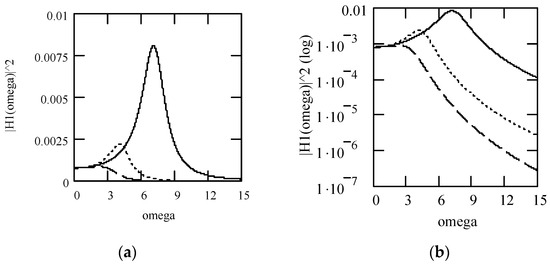
Figure 38.
Plots of |H1(ω)|2 with α = 1.8 (solid), 2.4 (dotted), and 2.8 (dashed) when m = 1 and k = 36. (a) |H1(ω)|2; (b) log|H1(ω)|2.
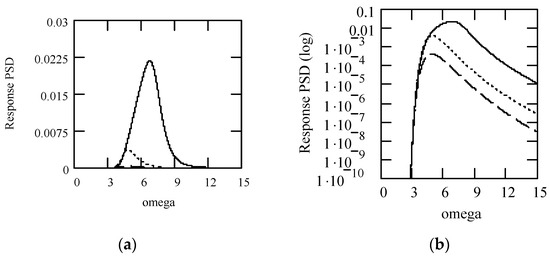
Figure 39.
Plots of response PSD Sxx1(ω) with α = 1.8 (solid), 2.4 (dotted), and 2.8 (dashed) when m = 1, k = 36, and V = 15. (a) Sxx1(ω); (b) logSxx1(ω).
When α = 2, a class I fractional vibrator reduces to be a conventional damping free vibrator. For α = 2, m = 1, c = 0.1, k = 36, and V = 15, a resonance occurs is indicated in Figure 40a. In Figure 41, we illustrate some plots of the cross-PSD response Sfx1(ω).
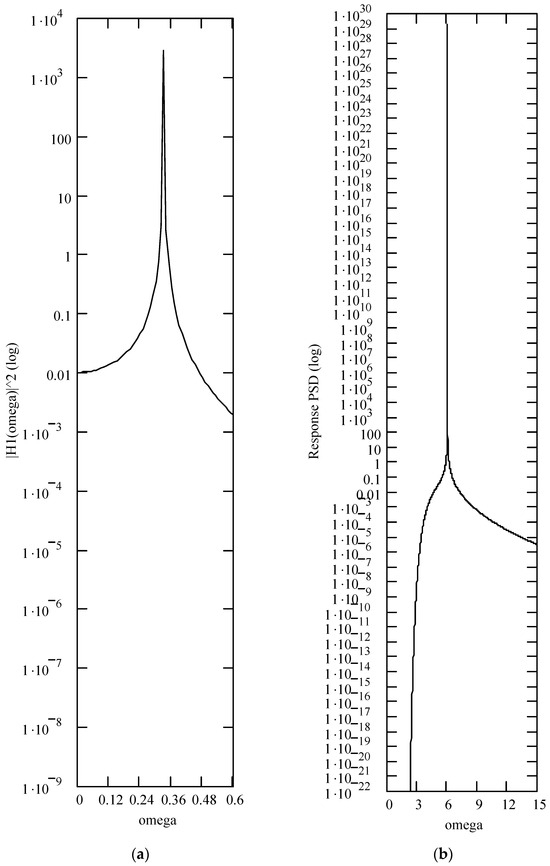
Figure 40.
Resonance when with α = 2, m = 1, k = 36, and V = 15. (a) Plot of log|H1(ω)|2; (b) plot of response PSD logSxx1(ω).
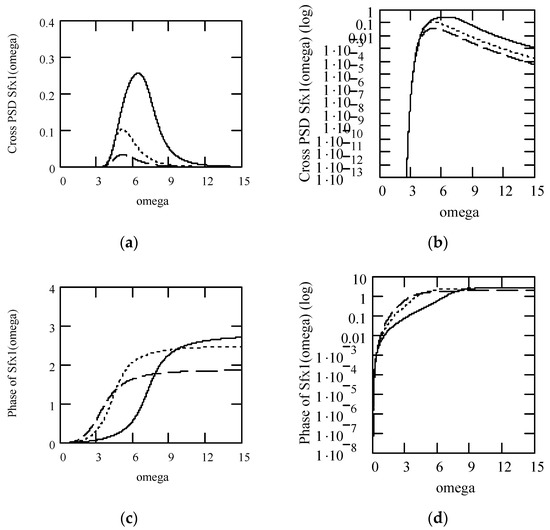
Figure 41.
Illustrations of cross-PSD response Sfx1(ω) with α = 1.8 (solid), 2.4 (dotted), and 2.8 (dashed) when m = 1, k = 36, and V = 15. (a) |Sfx1(ω)|; (b) log|Sfx1(ω)|; (c) Phase of Sfx1(ω). (d). Phase of Sfx1(ω) in log scale.
According to the random data generation used in Massel [100], Chairabarti [101], and Li [104], we illustrate some plots of driven signal f(t) and the response x1(t) in Figure 42.
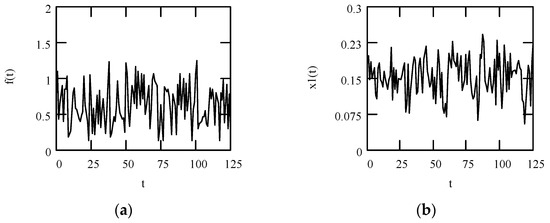
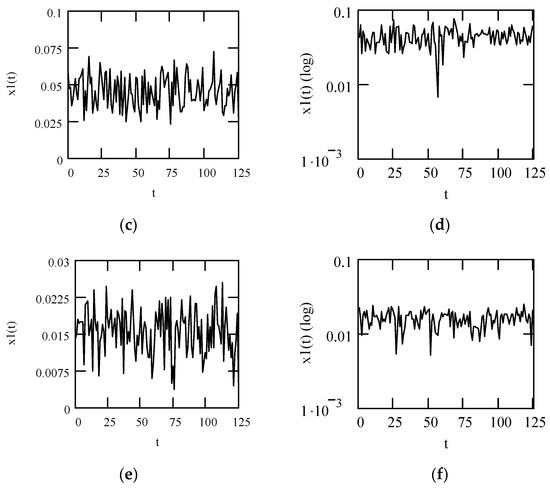
Figure 42.
Plots of random series of driven signal and response signals when m = 1, k = 36, and V = 15: (a) Driven signal. (b) Response x1(t) for α = 1.8. (c) Response x1(t) for α = 2.4. (d) Response x1(t) for α = 2.4 in log scale. (e) Response x1(t) for α = 2.8. (f) Response x1(t) for α = 2.8 in log scale.
There are noticeable effects of the fractional order α on the responses for class I fractional vibration systems driven by the P-M spectrum.
10.3. Responses of Class II Fractional Vibrators Driven by P-M Spectrum
10.3.1. Computation Methods
We write the equation of motion of a class II fractional vibrator as (312) for facilitating discussions
where f(t) is the excitation with the P-M spectrum and x2(t) is the system response.
Theorem 66 (PSD response II).
Let Sxx2(ω) be the PSD of the response x2(t). Equation (313) is its analytical expression
Proof.
Equation (314) gives the relationship between Sxx2(ω) and Sff(ω)
where
Thus, (313) is true and Theorem 66 is valid. This finishes the proof. □
Sxx2(ω) = Sff(ω)|H2(ω)|2,
Theorem 67 (Cross-PSD response II).
Denote by Sfx2(ω) the cross-PSD between f(t) and x2(t). Then, its expression is given by
Proof.
Due to the relationship between Sfx2(ω) and Sff(ω) in (316)
and
(315) is valid and Theorem 67 holds. The proof completes. □
Sfx2(ω) = Sff(ω)H2(ω),
In the time domain, one has the ACF response expressed by (317) below
and the cross-correlation response is expressed by (318) below
rxx2(τ) = rff(τ)∗h2(τ)∗h2(−τ),
rfx2(τ) = rff(τ)∗h2(τ).
10.3.2. Effects of β on Responses
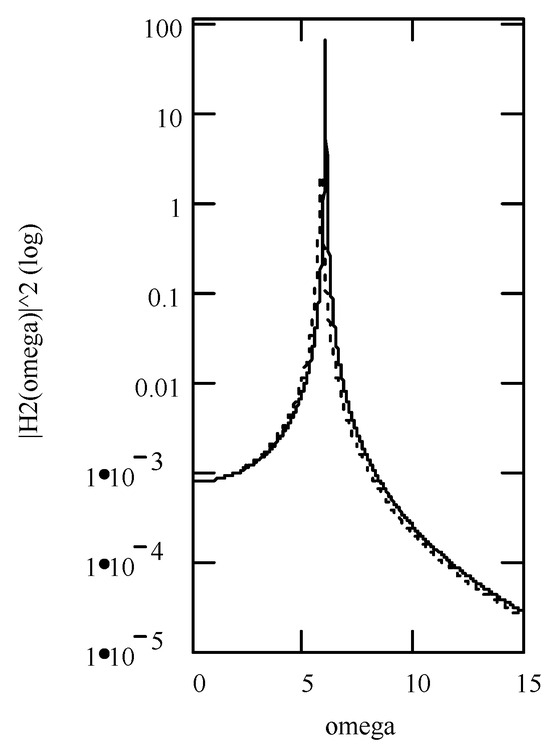
Figure 43.
Plots of |H2(ω)|2 (log) with β = 0.4 (solid) and 1.8 (dotted) when m = 1, c = 0.1, and k = 36.
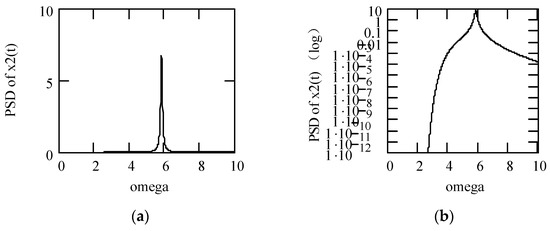
Figure 44.
Plots of PSD response Sxx2(ω) with β = 1.8 when m = 1, c = 0.1, k = 36, and V = 15: (a) Sxx2(ω). (b) logSxx2(ω).
When β = 1, a class II fractional vibrator becomes a conventional damping free vibrator. Figure 45 shows a resonance when β = 1. Figure 46 illustrates some plots of cross-PSD response Sfx2(ω).
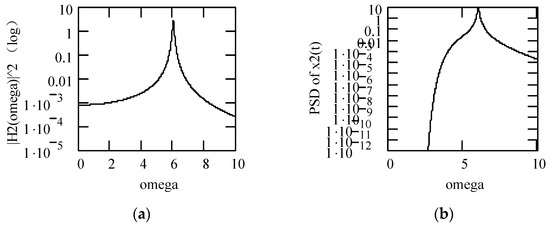
Figure 45.
Resonance when with β = 1, m = 1, c = 0.1, k = 36, and V = 15: (a) log|H2(ω)|2. (b) logSxx2(ω).
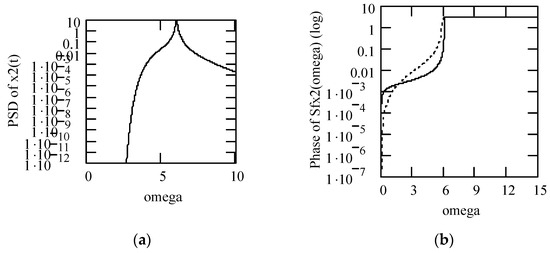
Figure 46.
Plots of cross-PSD response Sfx2(ω) with β = 0.4 (solid) and 1.8 (dot) when m = 1, c = 0.1, k = 36, and V = 15: (a) log|Sfx2(ω)|. (b) Phase of Sfx2(ω) in log scale.
There are effects of β on the responses for class II fractional vibration systems. Figure 47 exhibits the effects of β on the fluctuation range of the response x2(t).
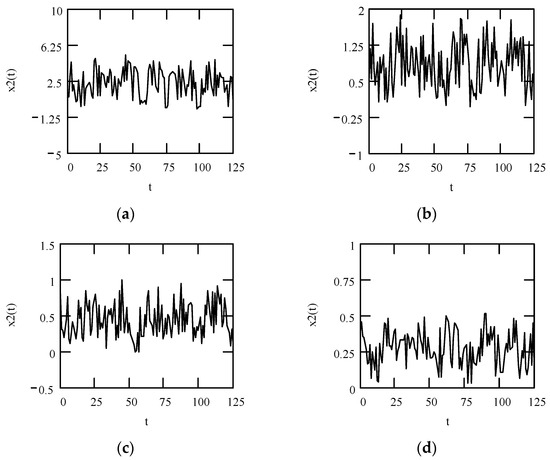
Figure 47.
Simulated response series x2(t) when m = 1, c = 0.1, k = 36, and V = 15: (a) x2(t) for β = 0.4. (b) x2(t) for β = 1. (c) x2(t) for β = 1.4. (d) x2(t) for β = 1.8.
10.4. Responses of Class III Fractional Vibrators Driven by P-M Spectrum
10.4.1. Computations
We write the motion equation of a class III fractional vibrator as (319) for facilitating discussions
where f(t) is the excitation with the P-M spectrum and x3(t) is the response.
Theorem 68 (PSD response III).
Let Sxx3(ω) be the PSD of the response x3(t). Then, (320) is its expression
Proof.
Note that Sxx3(ω) = Sff(ω)|H3(ω)|2. In addition,
Thus, (320) is true and Theorem 68 holds. The proof is finished. □
Theorem 69 (Cross-PSD response III).
Let Sfx3(ω) be the cross-PSD between f(t) and x3(t). Then, (321) is its expression
Proof.
As Sfx3(ω) = Sff(ω)H3(ω), we have (321) and Theorem 69 holds. The proof completes. □
In the time domain, we have the ACF response expressed by (322) in the form
and the cross-correlation response by (323) in the form
rxx3(τ) = rff(τ)∗h3(τ)∗h3(−τ),
rfx3(τ) = rff(τ)∗h3(τ).
10.4.2. Effects of α and β on Responses
We illustrate some plots of |H3(ω)|2 in Figure 48. Figure 49 indicates some plots of response PSD Sxx3(ω). Some plots of cross-PSD response Sfx3(ω) are indicated in Figure 50.

Figure 48.
Plots of |H3(ω)|2 when m = 1, c = 0.1, and k = 36 for (α, β) = (1.6, 0.8) (solid), (1.6, 1.8) (dotted), (2.5, 0.8) (dashed), (2.8, 1.8) (dashed–dotted). (a) |H3(ω)|2; (b) log|H3(ω)|2.
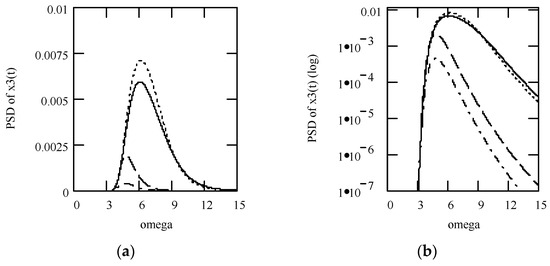
Figure 49.
Plots of response PSD Sxx3(ω) when m = 1, c = 0.1, k = 36, and V = 15 for (α, β) = (1.6, 0.8) (solid), (1.6, 1.8) (dotted), (2.5, 0.8) (dashed), and (2.8, 1.8) (dashed–dotted). (a) Sxx3(ω); (b) logSxx3(ω).
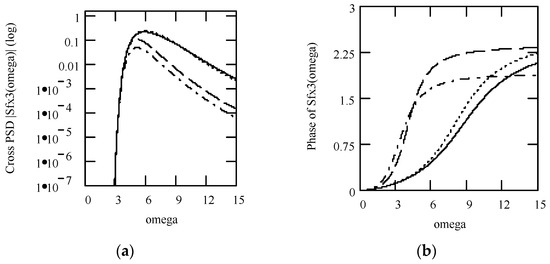
Figure 50.
Plots of cross-PSD response Sfx3(ω) when m = 1, c = 0.1, k = 36, and V = 15 for (α, β) = (1.6, 0.8) (solid), (1.6, 1.8) (dotted), (2.5, 0.8) (dashed), and (2.8, 1.8) (dashed–dotted). (a) log|Sfx3(ω)|; (b) Phase of |Sfx3(ω)|.
10.5. Responses of Class IV Fractional Vibrator Driven by P-M Spectrum
10.5.1. Computations
Equation (324) is the motion equation of a class IV fractional vibrator
where f(t) is the driven signal with the P-M spectrum and x4(t) is the response.
Theorem 70 (PSD response IV).
Let Sxx4(ω) be the PSD of the response x4(t). Then, (325) is its expression
Proof.
Because Sxx4(ω) = Sff(ω)|H4(ω)|2 and
(325) is true and Theorem 70 holds. This finishes the proof. □
Theorem 71 (Cross-PSD response IV).
Denote by Sfx4(ω) the cross-PSD between f(t) and x4(t). Then, its expression is given by
Proof.
Performing the operation of Sfx4(ω) = Sff(ω)H4(ω) yields (326). The proof is finished. □
Calculating the inverse Fourier transform on the both sides of Sxx4(ω) = Sff(ω)|H4(ω)|2 yields
In (327), rxx4(τ) is the ACF of x4(t). In addition, we have
In (328), rfx4(τ) is the cross-correlation between f(t) and x4(t). It is the cross-correlation response.
rxx4(τ) = rff(τ)∗h4(τ)∗h4(−τ).
rfx4(τ) = rff(τ)∗h4(τ).
10.5.2. Effects of α and λ on Responses
We illustrate some plots of |H4(ω)|2 in Figure 51. Figure 52 indicates some plots of Sxx4(ω). Some plots of Sfx4(ω) are shown in Figure 53.
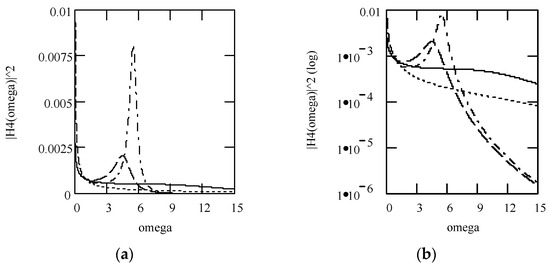
Figure 51.
Plots of |H4(ω)|2 when m = 1, c = 0, and k = 36 for (α, λ) = (1.6, 0.2) (solid), (1.6, 0.4) (dotted), (2.5, 0.2) (dashed), and (2.5, 0.4) (dashed–dotted). (a) |H4(ω)|2; (b) log|H4(ω)|2.
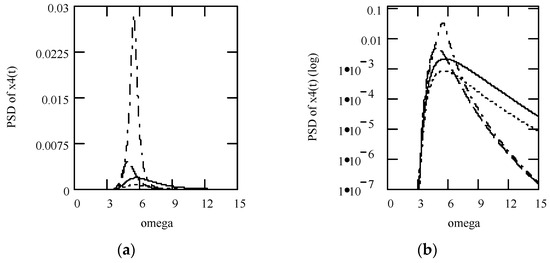
Figure 52.
Plots of response PSD Sxx4(ω) when m = 1, c = 0, k = 36, and V = 15 for (α, λ) = (1.6, 0.2) (solid), (1.6, 0.4) (dotted), (2.5, 0.2) (dashed), and (2.5, 0.4) (dashed–dotted). (a) Sxx4(ω); (b) logSxx4(ω).
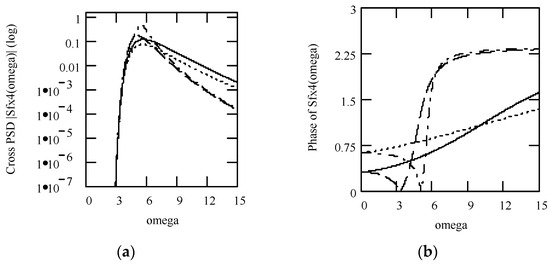
Figure 53.
Plots of cross-PSD response Sfx4(ω) when m = 1, c = 0, k = 36, and V = 15 for (α, λ) = (1.6, 0.2) (solid), (1.6, 0.4) (dotted), (2.5, 0.2) (dashed), and (2.5, 0.4) (dashed–dotted). (a) log|Sfx4(ω)|; (b) phase of |Sfx4(ω)|.
10.6. Responses of Class V Fractional Vibrators Driven by P-M Spectrum
10.6.1. Computations
In the motion equation of a class V fractional vibrator (329)
f(t) is the driven force with the P-M spectrum and x5(t) is the response.
Theorem 72 (PSD response V).
Denote by Sxx5(ω) the PSD of the response x5(t). Then, (330) is its expression
Proof.
Considering
and Sxx5(ω) = Sff(ω)|H5(ω)|2, we have (330) and Theorem 72 holds. The proof is completed. □
Theorem 73 (Cross-PSD response V).
Let Sfx5(ω) be the cross-PSD between f(t) and x5(t). Then, (331) is its expression
Proof.
Doing Sfx5(ω) = Sff(ω)H5(ω) yields (331). This finishes the proof. □
In the time domain, one has the ACF response in the form of (332)
and the cross-correlation response in the form of (333)
rxx5(τ) = rff(τ)∗h5(τ)∗h5(−τ),
rfx5(τ) = rff(τ)∗h5(τ).
10.6.2. Effects of λ on Responses
Figure 54 illustrates some plots of |H5(ω)|2. Figure 55 shows some plots of Sxx5(ω) and Figure 56 indicates some plots of Sfx5(ω).

Figure 54.
Plots of |H5(ω)|2 (log) when m = 1, c = 0, and k = 36 for λ = 0.2 (solid), 0.4 (dotted), 0.6 (dashed), and 0.8 (dashed–dotted).
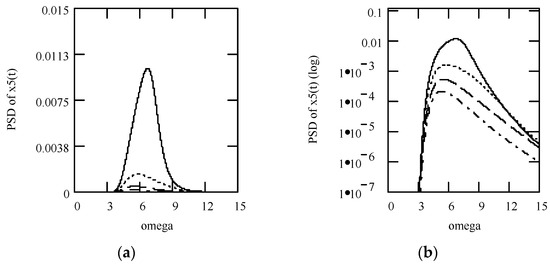
Figure 55.
Plots of response PSD Sxx5(ω) when m = 1, c = 0, k = 36, and V = 15 for λ = 0.2 (solid), 0.4 (dotted), 0.6 (dashed), and 0.8 (dashed–dotted): (a) Sxx5(ω); (b) logSxx5(ω).
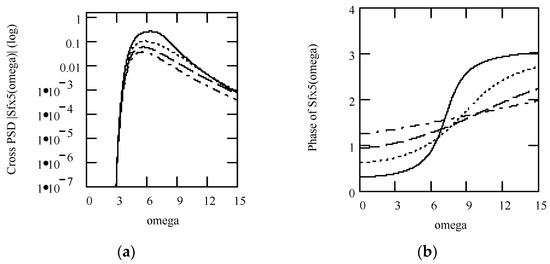
Figure 56.
Plots of cross-PSD response Sfx5(ω) when m = 1, c = 0, k = 36, and V = 15 for λ = 0.2 (solid), 0.4 (dotted), 0.6) (dashed), and 0.8 (dashed–dotted): (a) log|Sfx5(ω)|; (b) phase of |Sfx5(ω)|.
10.7. Responses of Class VI Fractional Vibrators Driven by P-M Spectrum
10.7.1. Computations
Consider the motion equation of a class VI fractional vibrator below
In (334), f(t) is the driven signal with the P-M spectrum and x6(t) is the response.
Theorem 74 (PSD response VI).
Let Sxx6(ω) be the PSD of the response x6(t). Then, (335) is its expression
Proof.
Performing the operation of Sxx6(ω) = Sff(ω)|H6(ω)|2 produces (335). The proof ends. □
Theorem 75 (cross-PSD response VI).
Denote by Sfx6(ω) the cross-PSD between f(t) and x6(t). Then, (336) is its expression
Proof.
Calculating Sfx6(ω) = Sff(ω)H6(ω) results in (336). The proof ends. □
In the time domain, we have (337) as the expression of the ACF response
and (338) as the expression of the cross-correlation response
rxx6(τ) = rff(τ)∗h6(τ)∗h6(−τ),
rfx6(τ) = rff(τ)∗h6(τ).
10.7.2. Effects of α, β, and λ on Responses
Figure 57 is used to illustrate some plots of |H6(ω)|2, Figure 58 is used for some plots of Sxx6(ω), and Figure 59 for some of Sfx6(ω).
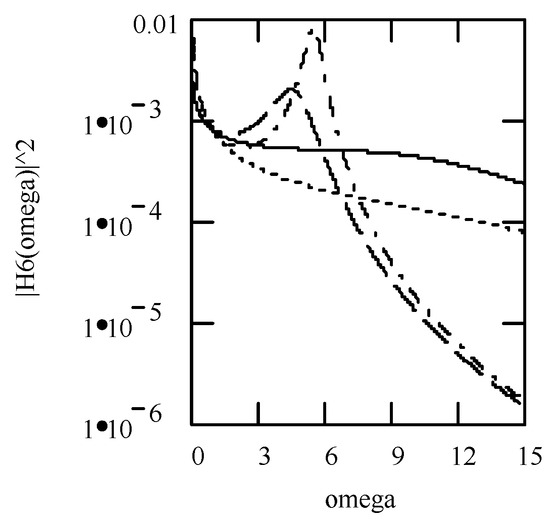
Figure 57.
Plots of |H6(ω)|2 (log) when m = 1, c = 0.1, and k = 36 for (α, β, λ) = (1.6, 0.8, 0.2) (solid), (1.6, 1.8, 0.4) (dotted), (2.5, 0.4, 0.2) (dashed), and (2.5, 0.8, 0.4) (dashed–dotted).
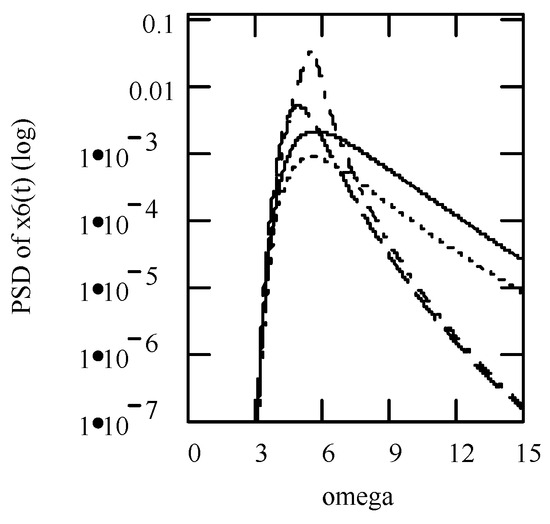
Figure 58.
Plots of response PSD Sxx6(ω) in log scale when m = 1, c = 0.1, k = 36, and V = 15 for (α, β, λ) = (1.6, 0.8, 0.2) (solid), (1.6, 1.8, 0.4) (dotted), (2.5, 0.4, 0.2) (dashed), and (2.5, 0.8, 0.4) (dashed–dotted).
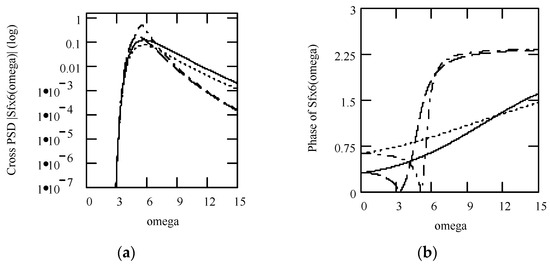
Figure 59.
Plots of cross-PSD response Sfx6(ω) when m = 1, c = 0.1, k = 36, and V = 15 for (α, β, λ) = (1.6, 0.8, 0.2) (solid), (1.6, 1.8, 0.4) (dotted), (2.5, 0.4, 0.2) (dashed), and (2.5, 0.8, 0.4) (dashed–dotted): (a) log|Sfx6(ω)|; (b) phase of |Sfx6(ω)|.
10.8. Responses of Class VII Fractional Vibrators Driven by P-M Spectrum
10.8.1. Computations
Equation (339) is the motion equation of a class VII fractional vibrator
where f(t) is the excitation with the P-M spectrum and x7(t) is the response.
Theorem 76 (PSD response VII).
Denote by Sxx7(ω) the PSD of the response x7(t). Then, (340) is its expression
Proof.
Performing Sxx7(ω) = Sff(ω)|H7(ω)|2 results in (340). This finishes the proof. □
Theorem 77 (Cross-PSD response VII).
Let Sfx7(ω) be the cross-PSD between f(t) and x7(t). Then, (341) is its expression
Proof.
Doing Sfx7(ω) = Sff(ω)H7(ω) yields (341). The proof ends. □
In the time domain, one has the ACF response expressed by (342) below
and the cross-correlation response given by (343) below
rxx7(τ) = rff(τ)∗h7(τ)∗h7(−τ),
rfx7(τ) = rff(τ)∗h7(τ).
10.8.2. Effects of β and λ on Responses
Figure 60 shows some plots of |H7(ω)|2. Figure 61 indicates some plots of Sxx7(ω). Figure 62 demonstrates some plots of Sfx7(ω).

Figure 60.
Plots of |H7(ω)|2 (log) when m = 1, c = 0.1, and k = 36, for (β, λ) = (0.5, 0.2) (solid), (0.5, 0.3) (dot), (1.5, 0.4) (dash), (1.5, 0.6) (dash dot).
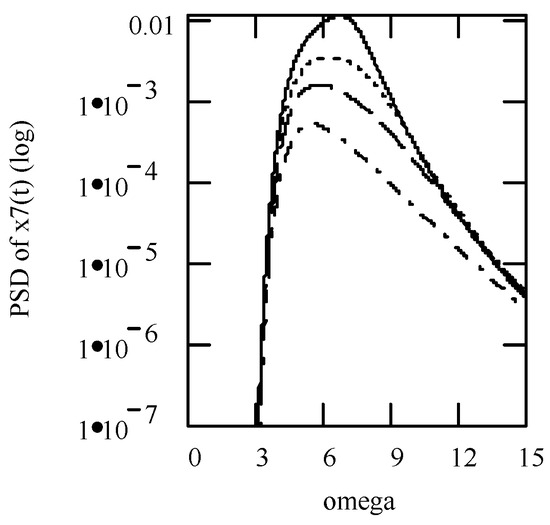
Figure 61.
Plots of response PSD Sxx7(ω) in log scale when m = 1, c = 0.1, k = 36, and V = 15 for (β, λ) = (0.5, 0.2) (solid), (0.5, 0.3) (dot), (1.5, 0.4) (dash), (1.5, 0.6) (dash dot).
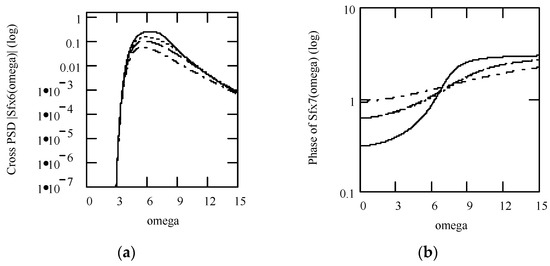
Figure 62.
Plots of cross-PSD response Sfx7(ω) when m = 1, c = 0.1, k = 36, and V = 15 for (β, λ) = (0.5, 0.2) (solid), (0.5, 0.3) (dot), (1.5, 0.4) (dash), (1.5, 0.6) (dash dot). (a). log|Sfx7(ω)|. (b). Phase of |Sfx7(ω)| in log scale.
10.9. Summary
We have presented the analytic expressions of the PSD and cross-PSD responses of fractional vibrators from class I to class VII in Theorems 64–77, respectively. We have shown that fractional orders of vibration systems, namely, α, β, and λ, have considerable effects on responses.
11. Application: Mathematical Explanation of Rayleigh Damping Assumption
In the field of structural mechanics, how to mathematically explain the Rayleigh damping assumption is a tough issue. We address two objectives in this section: One is to apply fractional vibrations to mathematically explain the Rayleigh damping assumption. The other is to show that a vibration system with the Rayleigh damping is with frequency-dependent mass, damping, and stiffness in reality.
11.1. Mathematical Explanation
Denote by cr the damping assumed by Rayleigh for a system with the primary mass m and the primary stiffness k. Its standard form is given by
where a and b are frequency-dependent parameters. To be precise, a is proportional to ω while b is inversely proportional to ω. In short, Rayleigh assumed that damping is proportional to m and k with the coefficients a and b (Harris [71], Palley et al. [72], Rayleigh [105]). We have already used (344) in Section 9. The literature with respect to applications of the Rayleigh damping assumption is rich, see, e.g., Trombetti and Silvestri [106], Poul and Zerva [107], Nåvik et al. [108], Park et al. [109], Hussein et al. [110], Sigmund and Jensen [111], Chen et al. [112], Battisti et al. [113], Cox et al. [114], Tisseur and Meerbergen [115], Chu et al. [116], Fay et al. [117], Naderian et al. [118], Tian et al. [119], Iovane and Nasedkin [120], Kouris et al. [121], Jin and Xia [122], DeWeaver and Nigam [123], Langley [124], Bhaskar [125], Horiuchi and Konno [126], Mohammad et al. [127], and Kim and Wiebe [128], just to mention a few.
According to the properties of a and b in (344), we rewrite it as (345) below
We use (346) to express the above a(ω) and a(ω)
Thus, we have (347) to express cr(ω) in the form
cr = cr(ω) = a(ω)m + b(ω)k.
The above is just the equivalent damping of class IV fractional vibrators (see Corollary 30 in Section 6). Therefore, the class IV fractional vibrators may yet provide us with a model to mathematically explain the famous Rayleigh damping assumption, referring to Li [26] for more explanations.
11.2. Frequency Dependency of Elements: A View from Rayleigh Damping Assumption
We call mass or damping or stiffness an element of a vibration system. When the damping of a vibration system follows cr(ω), we denote its mass and stiffness by m = mr(ω) and k = kr(ω), respectively. As a matter of fact, mr(ω) and kr(ω) are, respectively, expressed by (348) and (349). To be precise,
and
Thus, mr and kr are also frequency-dependent. Consequently. When applying the Rayleigh damping assumption to a vibration system, we have the general form of the motion equation of a vibration system with frequency-dependent elements in the form (350) below
As a whole, we say that a system with the Rayleigh damping is with frequency-dependent mass and stiffness in addition to frequency-dependent damping cr(ω).
12. Summary and Conclusions
Among seven classes of fractional vibrators that are listed in (1), (4), (6), (10), (11), (13), and (14) in Section 1, class VI is the general one. Thus, we start our review work from the class VI fractional vibrators in Section 2.
Regarding a class VI fractional vibrator, performing the Fourier transform on its fractional motion Equation (13) easily yields its frequency transfer function H6(ω), see Theorem 2. Starting from H6(ω), we can easily derive its equivalent motion Equation (18) in Theorem 2. Based on Theorem 2, for a class VI fractional vibrator, it is consequent for us to derive the analytical expressions of its equivalent mass (Corollary 1), equivalent damping (Corollary 2), equivalent stiffness (Corollary 3), equivalent damping ratio (Corollary 4), equivalent damping free natural angular frequency (Corollary 5), equivalent damped natural angular frequency (Corollary 6), and equivalent frequency ratio (Corollary 7). Therefore, based on the equivalent vibration parameters, it is natural for us to derive the analytical expressions of free response (Theorem 3), impulse response (Theorem 4), step response (Theorem 5), sinusoidal response (Theorem 6), equivalent logarithmic decrement (Theorem 7), equivalent Q factor (Theorem 8), and equivalent frequency bandwidth (Theorem 9).
Because class I (or II, III, IV, V, or VII) is a special case of class VI, the analytic theory of class I (or II, III, IV, V, or VII) with elementary functions is a consequent of that of class VI, which is, respectively, discussed in Section 3, Section 4, Section 5, Section 6, Section 7 and Section 8.
Three applications of seven classes of fractional vibrations were discussed. Section 9 reviews the application to the analytical expression of the forced response to a damped Euler–Bernoulli beam. In Section 10, we presented the analytical expressions of power spectrum density response and cross-power spectrum density response of seven classes of fractional vibrations under the excitation with Pierson and Moskowitz spectrum. In Section 11, we reviewed a possible mathematical explanation of the Rayleigh damping assumption based on class IV fractional vibrators. In the case of the Rayleigh damping assumption, elements are frequency-dependent.
The analytical expressions of the frequency bandwidth in seven classes of fractional vibrators and the sinusoidal responses to fractional vibrators from class IV to VII are newly introduced in this paper. We have not reviewed the recent work by Li [129] on stationary responses using a fractional phasor.
The theory of fractional vibrations reviewed in this paper refers to a kind of nonlinear vibration. The nonlinearity of fractional vibrations can be explained from the point of view of fractional inertia or fractional damping or fractional stiffness; refer to Li [26] for details. Such a nonlinear vibration differs from the conventional nonlinear vibration described by, for example, the Duffing, van der Pol, or Duffing–van der Pol equation (Az-Zo’bi et al. [130]; Ren et al. [131]; El-Dib [132]; El-Nabulsi and Anukool [133]). From a structural mechanics perpective, vibration is strongly associated with the subject of fatigue (Harris [71]; Palley et al. [72]). Therefore, fractional fatigue may be an interesting issue to work on in future. In theory, the topic of fractional vibration symmetry/asymmetry would be interesting.
Funding
This research received no external funding.
Data Availability Statement
Not applicable.
Conflicts of Interest
The author declares no conflict of interest.
References
- Duan, J.-S. The periodic solution of fractional oscillation equation with periodic input. Adv. Math. Phys. 2013, 2013, 869484. [Google Scholar] [CrossRef]
- Duan, J.-S.; Wang, Z.; Liu, Y.-L.; Qiu, X. Eigenvalue problems for fractional ordinary differential equations. Chaos Solitons Fractals 2013, 46, 46–53. [Google Scholar] [CrossRef]
- Zurigat, M. Solving fractional oscillators using Laplace homotopy analysis method. Ann. Univ. Craiova Math. Comput. Sci. Ser. 2011, 38, 1–11. [Google Scholar]
- Blaszczyk, T.; Ciesielski, M. Fractional oscillator equation–Transformation into integral equation and numerical solution. Appl. Math. Comput. 2015, 257, 428–435. [Google Scholar] [CrossRef]
- Blaszczyk, T.; Ciesielski, M.; Klimek, M.; Leszczynski, J. Numerical solution of fractional oscillator equation. Appl. Math. Comput. 2011, 218, 2480–2488. [Google Scholar]
- Blaszczyk, T. A numerical solution of a fractional oscillator equation in a non-resisting medium with natural boundary conditions. Rom. Rep. Phys. 2015, 67, 350–358. [Google Scholar]
- Al-Rabtah, A.; Ertürk, V.S.; Momani, S. Solutions of a fractional oscillator by using differential transform method. Comput. Math. Appl. 2010, 59, 1356–1362. [Google Scholar]
- Drozdov, A.D. Fractional oscillator driven by a Gaussian noise. Phys. A 2007, 376, 237–245. [Google Scholar] [CrossRef]
- Stanislavsky, A.A. Fractional oscillator. Phys. Rev. E 2004, 70, 051103. [Google Scholar]
- Achar, B.N.N.; Hanneken, J.W.; Clarke, T. Damping characteristics of a fractional oscillator. Phys. A 2004, 339, 311–319. [Google Scholar]
- Achar, B.N.N.; Hanneken, J.W.; Clarke, T. Response characteristics of a fractional oscillator. Phys. A 2002, 309, 275–288. [Google Scholar] [CrossRef]
- Achar, B.N.N.; Hanneken, J.W.; Enck, T.; Clarke, T. Dynamics of the fractional oscillator. Phys. A 2001, 297, 361–367. [Google Scholar] [CrossRef]
- Tofighi, A. The intrinsic damping of the fractional oscillator. Phys. A 2003, 329, 29–34. [Google Scholar] [CrossRef]
- Ryabov, Y.E.; Puzenko, A. Damped oscillations in view of the fractional oscillator equation. Phys. Rev. B 2002, 66, 184201. [Google Scholar] [CrossRef]
- Ahmad, W.E.; Elwakil, A.S.R. Fractional-order Wien-bridge oscillator. Electron. Lett. 2001, 37, 1110–1112. [Google Scholar] [CrossRef]
- Uchaikin, V.V. Fractional Derivatives for Physicists and Engineers; Springer: Berlin/Heidelberg, Germany, 2013; Volume II. [Google Scholar]
- Tavazoei, M.S. Reduction of oscillations via fractional order pre-filtering. Signal Process. 2015, 107, 407–414. [Google Scholar] [CrossRef]
- Sandev, T.; Tomovski, Z. The general time fractional wave equation for a vibrating string. J. Phys. A Math. Theor. 2010, 43, 055204. [Google Scholar] [CrossRef]
- Singh, H.; Srivastava, H.M.; Kumar, D. A reliable numerical algorithm for the fractional vibration equation. Chaos Solitons Fractals 2017, 103, 131–138. [Google Scholar] [CrossRef]
- Rossikhin, Y.A. Reflections on two parallel ways in progress of fractional calculus in mechanics of solids. Appl. Mech. Rev. 2010, 63, 010701. [Google Scholar] [CrossRef]
- Pskhu, A.V.; Rekhviashvili, S.S. Analysis of forced oscillations of a fractional oscillator. Tech. Phys. Lett. 2018, 44, 1218–1221. [Google Scholar] [CrossRef]
- Aghchi, S.; Fazli, H.; Sun, H.G. A numerical approach for solving optimal control problem of fractional order vibration equation of large membranes. Comput. Math. Appl. 2024, 165, 19–27. [Google Scholar] [CrossRef]
- Čermák, J.; Kisela, T. Stabilization and destabilization of fractional oscillators via a delayed feedback control. Commun. Nonlinear Sci. Numer. Simul. 2023, 117, 106960. [Google Scholar] [CrossRef]
- Li, M. Three classes of fractional oscillators. Symmetry 2018, 10, 40. [Google Scholar] [CrossRef]
- Li, M. Theory of Fractional Engineering Vibrations; Walter de Gruyter: Berlin, Germany; Boston, MA, USA, 2021. [Google Scholar]
- Li, M. Fractional Vibrations with Applications to Euler-Bernoulli Beams; CRC Press: Boca Raton, UK, 2023. [Google Scholar]
- Lin, L.-F.; Chen, C.; Zhong, S.-C.; Wang, H.-Q. Stochastic resonance in a fractional oscillator with random mass and random frequency. J. Stat. Phys. 2015, 160, 497–511. [Google Scholar] [CrossRef]
- Hermosillo-Arteaga, A.; Romo, M.P.; Magaña-del-Toro, R. Response spectra generation using a fractional differential model. Soil Dyn. Earthq. Eng. 2018, 115, 719–729. [Google Scholar] [CrossRef]
- Alkhaldi, H.S.; Abu-Alshaikh, I.M.; Al-Rabadi, A.N. Vibration control of fractionally-damped beam subjected to a moving vehicle and attached to fractionally-damped multi-absorbers. Adv. Math. Phys. 2013, 2013, 232160. [Google Scholar] [CrossRef]
- Dai, H.; Zheng, Z.; Wang, W. On generalized fractional vibration equation. Chaos Solitons Fractals 2017, 95, 48–51. [Google Scholar] [CrossRef]
- Xu, Y.; Li, Y.; Liu, D.; Jia, W.; Huang, H. Responses of Duffing oscillator with fractional damping and random phase. Nonlinear Dyn. 2013, 74, 745–753. [Google Scholar] [CrossRef]
- He, G.; Tian, Y.; Wang, Y. Stochastic resonance in a fractional oscillator with random damping strength and random spring stiffness. J. Stat. Mech. Theory Exp. 2013, 2013, P09026. [Google Scholar] [CrossRef]
- Leung, A.Y.T.; Guo, Z.; Yang, H.X. Fractional derivative and time delay damper characteristics in Duffing-van der Pol oscillators. Commun. Nonlinear Sci. Numer. Simul. 2013, 18, 2900–2915. [Google Scholar] [CrossRef]
- Chen, L.C.; Zhuang, Q.Q.; Zhu, W.Q. Response of SDOF nonlinear oscillators with lightly fractional derivative damping under real noise excitations. Eur. Phys. J. Spec. Top. 2011, 193, 81–92. [Google Scholar] [CrossRef]
- Deü, J.-F.; Matignon, D. Simulation of fractionally damped mechanical systems by means of a Newmark-diffusive scheme. Comput. Math. Appl. 2010, 59, 1745–1753. [Google Scholar] [CrossRef]
- Drăgănescu, G.E.; Bereteu, L.; Ercuţa, A.; Luca, G. Anharmonic vibrations of a nano-sized oscillator with fractional damping. Commun. Nonlinear Sci. Numer. Simul. 2010, 15, 922–926. [Google Scholar] [CrossRef]
- Xie, F.; Lin, X. Asymptotic solution of the van der Pol oscillator with small fractional damping. Phys. Scr. 2009, 2009, 014033. [Google Scholar] [CrossRef]
- Ren, R.; Luo, M.; Deng, K. Stochastic resonance in a fractional oscillator driven by multiplicative quadratic noise. J. Stat. Mech. Theory Exp. 2017, 2017, 023210. [Google Scholar] [CrossRef]
- Ren, R.; Luo, M.; Deng, K. Stochastic resonance in a fractional oscillator subjected to multiplicative trichotomous noise. Nonlinear Dyn. 2017, 90, 379–390. [Google Scholar] [CrossRef]
- Yuan, J.; Zhang, Y.; Liu, J.; Shi, B.; Gai, M.; Yang, S. Mechanical energy and equivalent differential equations of motion for single-degree-of-freedom fractional oscillators. J. Sound Vib. 2017, 397, 192–203. [Google Scholar] [CrossRef]
- Shitikova, M.V. The fractional derivative expansion method in nonlinear dynamic analysis of structures. Nonlinear Dyn. 2020, 99, 109–122. [Google Scholar] [CrossRef]
- Lin, L.-F.; Chen, C.; Wang, H.-Q. Trichotomous noise induced stochastic resonance in a fractional oscillator with random damping and random frequency. J. Stat. Mech. Theory Exp. 2016, 2016, 023201. [Google Scholar] [CrossRef]
- Naranjani, Y.; Sardahi, Y.; Chen, Y.-Q.; Sun, J.-Q. Multi-objective optimization of distributed-order fractional damping. Commun. Nonlinear Sci. Numer. Simul. 2015, 24, 159–168. [Google Scholar] [CrossRef]
- Duan, J.S.; Zhang, Y.Y. Discriminant and root trajectories of characteristic equation of fractional vibration equation and their effects on solution components. Fractal Fract. 2022, 6, 514. [Google Scholar] [CrossRef]
- Di Matteo, A.; Spanos, P.D.; Pirrotta, A. Approximate survival probability determination of hysteretic systems with fractional derivative elements. Probabilistic Eng. Mech. 2018, 54, 138–146. [Google Scholar] [CrossRef]
- Tomovski, Ž.; Sandev, T. Effects of a fractional friction with power-law memory kernel on string vibrations. Comput. Math. Appl. 2011, 62, 1554–1561. [Google Scholar] [CrossRef]
- Zelenev, V.M.; Meshkov, S.I.; Rossikhin, Y.A. Damped vibrations of hereditary-elastic systems with weakly singular kernels. J. Appl. Mech. Tech. Phys. 1970, 11, 290–293. [Google Scholar] [CrossRef]
- Rossikhin, Y.A.; Shitikova, M.V. New approach for the analysis of damped vibrations of fractional oscillators. Shock. Vib. 2009, 16, 365–387. [Google Scholar] [CrossRef]
- Rossikhin, Y.A.; Shitikova, M.V. Applications of fractional calculus to dynamic problems of linear and nonlinear hereditary mechanics of solids. Appl. Mech. Rev. 1997, 50, 15–67. [Google Scholar] [CrossRef]
- Rossikhin, Y.A.; Shitikova, M.V. Application of fractional calculus for dynamic problems of solid mechanics: Novel trends and recent results. Appl. Mech. Rev. 2010, 63, 010801. [Google Scholar] [CrossRef]
- Bagley, R.; Torvik, P.J. A generalized derivative model for an elastomer damper. Shock Vibr. Bull. 1979, 49, 135–143. [Google Scholar]
- Spanos, P.D.; Malara, G. Nonlinear random vibrations of beams with fractional derivative elements. J. Eng. Mech. 2014, 140, 04014069. [Google Scholar] [CrossRef]
- Spanos, P.D.; Malara, G. Nonlinear vibrations of beams and plates with fractional derivative elements subject to combined harmonic and random excitations. Probabilist. Eng. Mech. 2020, 59, 103043. [Google Scholar] [CrossRef]
- Hu, R.C.; Zhang, D.X.; Deng, Z.C.; Xu, C.H. Stochastic analysis of a nonlinear energy harvester with fractional derivative damping. Nonlinear Dyn. 2022, 108, 1973–1986. [Google Scholar] [CrossRef]
- Cao, Q.Y.; Hu, S.-L.J.; Li, H.J. Frequency/Laplace domain methods for computing transient responses of fractional oscillators. Nonlinear Dyn. 2022, 108, 1509–1523. [Google Scholar] [CrossRef]
- Cao, Q.Y.; Hu, S.-L.J.; Li, H.J. Nonstationary response statistics of fractional oscillators to evolutionary stochastic excitation. Commun. Nonlinear Sci. Numer. Simul. 2021, 103, 105962. [Google Scholar] [CrossRef]
- Kaltenbacher, B.; Schlintl, A. Fractional time stepping and adjoint based gradient computation in an inverse problem for a fractionally damped wave equation. J. Comput. Phys. 2022, 449, 110789. [Google Scholar] [CrossRef]
- Pang, D.H.; Jiang, W.; Liu, S.; Jun, D. Stability analysis for a single degree of freedom fractional oscillator. Phys. A 2019, 523, 498–506. [Google Scholar] [CrossRef]
- Gomez-Aguilar, J.F.; Rosales-Garcia, J.J.; Bernal-Alvarado, J.J.; Cordova-Fraga, T.; Guzman-Cabrera, R. Fractional mechanical oscillators. Rev. Mex. Fis. 2012, 58, 348–352. [Google Scholar]
- Tian, Y.; Zhong, L.-F.; He, G.-T.; Yu, T.; Luo, M.-K.; Stanley, H.E. The resonant behavior in the oscillator with double fractional-order damping under the action of nonlinear multiplicative noise. Phys. A 2018, 490, 845–856. [Google Scholar] [CrossRef]
- Berman, M.; Cederbaum, L.S. Fractional driven-damped oscillator and its general closed form exact solution. Phys. A 2018, 505, 744–762. [Google Scholar] [CrossRef]
- Duan, J.-S.; Li, M.; Wang, Y.; An, Y.-L. Approximate solution of fractional differential equation by quadratic splines. Fractal Fract. 2022, 6, 369. [Google Scholar] [CrossRef]
- Mendiola-Fuentes, J.; Guerrero-Ruiz, E.; Rosales-García, J. Multivariate Mittag-Leffler solution for a forced fractional-order harmonic oscillator. Mathematics 2024, 12, 1502. [Google Scholar] [CrossRef]
- Morales-Delgado, V.F.; Gómez-Aguilar, J.F.; Taneco-Hernández, M.A.; Escobar-Jiménez, R.F. A novel fractional derivative with variable- and constant-order applied to a mass-spring-damper system. Eur. Phys. J. Plus 2018, 133, 78. [Google Scholar] [CrossRef]
- Parovik, R.I. Amplitude-frequency and phase-frequency performances of forced oscillations of a nonlinear fractional oscillator. Tech. Phys. Lett. 2019, 45, 660–663. [Google Scholar] [CrossRef]
- Parovik, R.I. Quality factor of forced oscillations of a linear fractional oscillator. Tech. Phys. 2020, 65, 1015–1019. [Google Scholar] [CrossRef]
- Sene, N.; Aguilar, J.F.G. Fractional mass-spring-damper system described by generalized fractional order derivatives. Fractal Fract. 2019, 3, 39. [Google Scholar] [CrossRef]
- Duan, S.; Zhang, Y.; Qiu, X. Exact solutions of fractional order oscillation equation with two fractional derivative terms. J. Nonlinear Math. Phys. 2023, 30, 531–552. [Google Scholar] [CrossRef]
- Li, M. PSD and cross PSD of responses of seven classes of fractional vibrations driven by fGn, fBm, fractional OU process, and von Kármán process. Symmetry 2024, 16, 635. [Google Scholar] [CrossRef]
- Duan, J.-S. A modified fractional derivative and its application to fractional vibration equation. Appl. Math. Inf. Sci. 2016, 10, 1863–1869. [Google Scholar] [CrossRef]
- Harris, C.M. Shock and Vibration Handbook, 5th ed.; McGraw-Hill: New York, NY, USA, 2002. [Google Scholar]
- Palley, O.M.; Bahizov, B.; Voroneysk, E.R. Handbook of Ship Structural Mechanics; Xu, B.H.; Xu, X.; Xu, M.Q., Translators; National Defense Industry Publishing House: Beijing, China, 2002. (In Chinese) [Google Scholar]
- Lewis, E.V. (Ed.) Vol. II: Resistance, Propulsions and Vibration. In Principles of Naval Architecture, 2nd rev. ed.; The Society of Naval Architects and Marine Engineers (SNAME): Alexandria, VA, USA, 1988. [Google Scholar]
- Ouzizi, A.; Abdoun, F.; Azrar, L. Nonlinear dynamics of beams on nonlinear fractional viscoelastic foundation subjected to moving load with variable speed. J. Sound Vib. 2022, 523, 116730. [Google Scholar] [CrossRef]
- Lewandowski, R.; Baum, M. Dynamic characteristics of multilayered beams with viscoelastic layers described by the fractional Zener model. Arch. Appl. Mech. 2015, 82, 1793–1824. [Google Scholar] [CrossRef]
- Nešić, N.; Cajić, M.; Karličić, D.; Obradović, A.; Simonović, J. Nonlinear vibration of a nonlocal functionally graded beam on fractional visco-Pasternak foundation. Nonlinear Dyn. 2022, 107, 2003–2026. [Google Scholar] [CrossRef]
- Rossikhin, Y.A.; Shitikova, M.V. Classical beams and plates in a fractional derivative medium, Impact response. In Encyclopedia of Continuum Mechanics; Springer: Berlin/Heidelberg, Germany, 2020; Volume 1, pp. 294–305. [Google Scholar]
- Freundlich, J. Vibrations of a simply supported beam with a fractional derivative viscoelastic material model-supports movement excitation. Shock. Vib. 2013, 20, 126735. [Google Scholar]
- Freundlich, J. Transient vibrations of a fractional Kelvin-Voigt viscoelastic cantilever beam with a tip mass and subjected to a base excitation. J. Sound Vib. 2019, 438, 99–115. [Google Scholar] [CrossRef]
- Freundlich, J. Dynamic response of a simply supported viscoelastic beam of a fractional derivative type to a moving force load. J. Theor. Appl. Mech. 2016, 54, 1433–1445. [Google Scholar] [CrossRef][Green Version]
- Crandall, S.H.; Mark, W.D. Random Vibration in Mechanical Systems; Elsevier Inc.: New York, NY, USA; London, UK, 1963. [Google Scholar]
- Nakagawa, K.; Ringo, M. Engineering Vibrations; Xia, S.R., Translator; Shanghai Science and Technology Publishing House: Shanghai, China, 1981. (In Chinese) [Google Scholar]
- Lalanne, C. Mechanical Vibration and Shock, 2nd ed.; John Wiley & Sons: London, UK, 2009; Volume 3. [Google Scholar]
- Nigam, N.C. Introduction to Random Vibrations; The MIT Press: Cambridge, MA, USA, 1983. [Google Scholar]
- Preumont, A. Random Vibration and Spectral Analysis; Kluwer Academic Publishers: Dordrecht, The Netherlands, 1994. [Google Scholar]
- Preumont, A. Twelve Lectures on Structural Dynamics, Solid Mechanics and Its Applications; Springer: New York, NY, USA, 2013; Volume 198. [Google Scholar]
- Soong, T.T.; Grigoriu, M. Random Vibration of Mechanical and Structural Systems; Prentice-Hall: New York, NY, USA, 1992. [Google Scholar]
- Thomson, W.T.; Dahleh, M.D. Theory of Vibration with Applications, 5th ed.; Prentice-Hall: Upper Saddle River, NJ, USA, 1998. [Google Scholar]
- Lutes, L.D.; Sarkani, S.; Vibrations, R. Analysis of Structural and Mechanical Systems; Elsevier: Amsterdam, The Netherlands; Butterworth-Heinemann: Oxford, UK, 2004. [Google Scholar]
- Elishakoff, I.; Lyon, R.H. Random Vibration Status and Recent Developments; Elsevier: New York, NY, USA, 1986. [Google Scholar]
- Jensen, J.J. Load and Global Response of Ships; Elsevier: Amsterdam, The Netherlands; Academic Press: Oxford, UK, 2001; Volume 4. [Google Scholar]
- Rothbart, H.A.; Brown, T.H., Jr. Mechanical Design Handbook, 2nd ed.; Measurement, Analysis and Control of Dynamic Systems; McGraw–Hill: New York, NY, USA, 2006. [Google Scholar]
- Simiu, E.; Scanlan, R.H. Wind Effects on Structures: Fundamentals and Applications to Design, 3rd ed.; John Wiley & Sons: Hoboken, NJ, USA, 1996. [Google Scholar]
- Ra, S.S. Mechanical Vibrations, Sixth Edition in SI Units; Pearson Education: Harlow, UK, 2018. [Google Scholar]
- Dhanak, R.; Xiros, I. Springer Handbook of Ocean Engineering; Springer: Dordrecht, The Netherland; Heidelberg, Germany, 2016. [Google Scholar]
- Findeisen, D. System Dynamics and Mechanical Vibrations, An Introduction; Springer: Berlin/Heidelberg, Germany, 2000. [Google Scholar]
- Mukhopadhyay, M. Structural Dynamics: Vibrations and Systems; Springer: Cham, Switzerland, 2021. [Google Scholar]
- Cheli, F.; Diana, G. Advanced Dynamics of Mechanical Systems; Springer: Cham, Switzerland, 2015. [Google Scholar]
- Lewis, E.V. (Ed.) Vol. III: Motions in Waves and Controllability. In Principles of Naval Architecture, 2nd rev. ed.; The Society of Naval Architects and Marine Engineers (SNAME): Alexandria, VA, USA, 1989. [Google Scholar]
- Massel, S.R. Ocean Surface Waves: Their Physics and Prediction; World Scientific: Singapore, 1997. [Google Scholar]
- Chairabarti, S.K. Offshore Structure Modeling; World Scientific: Singapore, 1994. [Google Scholar]
- Li, M. A method for requiring block size for spectrum measurement of ocean surface waves. IEEE Trans. Instrum. Meas. 2006, 55, 2207–2215. [Google Scholar] [CrossRef]
- The Specialist Committee on Waves. Final Report and Recommendations to the 23rd ITTC. In Proceedings of the 23rd ITTC, Venice, Italy,, 8–14 September 2002; Volume II, pp. 497–543.
- Li, M. Generation of teletraffic of generalized Cauchy type. Phys. Scr. 2010, 81, 025007. [Google Scholar] [CrossRef]
- Strutt, J.W.; Rayleigh, J.W.S. The Theory of Sound. Macmillan & Co., Ltd.: London, UK, 1877; Volume 1. [Google Scholar]
- Trombetti, T.; Silvestri, S. On the modal damping ratios of shear-type structures equipped with Rayleigh damping systems. J. Sound Vib. 2006, 292, 21–58. [Google Scholar] [CrossRef]
- Poul, M.K.; Zerva, A. Efficient time-domain deconvolution of seismic ground motions using the equivalent-linear method for soil-structure interaction analyses. Soil Dyn. Earthq. Eng. 2018, 112, 138–151. [Google Scholar] [CrossRef]
- Nåvik, P.; Rønnquist, A.; Stichel, S. Identification of system damping in railway catenary wire systems from full-scale measurements. Eng. Struct. 2016, 113, 71–78. [Google Scholar] [CrossRef]
- Park, S.-K.; Park, H.W.; Shin, S.; Lee, H.S. Detection of abrupt structural damage induced by an earthquake using a moving time window technique. Comput. Struct. 2008, 86, 1253–1265. [Google Scholar] [CrossRef]
- Hussein, M.I.; Biringen, S.; Bilal, O.R.; Kucala, A. Flow stabilization by subsurface phonons. Proc. Math. Phys. Eng. Sci. 2015, 471, 20140928. [Google Scholar] [CrossRef]
- Sigmund, O.; Jensen, J.S. Systematic design of phononic band-gap materials and structures by topology optimization. Philos. Trans. Math. Phys. Eng. Sci. 2003, 361, 1001–1019. [Google Scholar] [CrossRef] [PubMed]
- Chen, F.; Tan, H.; Chen, J.; Jiao, Z. Influences of earthquake characteristics on seismic performance of anchored sheet pile quay with barrette piles. J. Coast. Res. 2018, 85, 701–705. [Google Scholar] [CrossRef]
- Battisti, D.S.; Hirst, A.C.; Sarachik, E.S. Instability and predictability in coupled atmosphere-ocean models. Philos. Trans. R. Soc. London. Ser. A Math. Phys. Sci. 1989, 329, 237–247. [Google Scholar]
- Cox, D.; Kämpf, J.; Fernandes, M. Dispersion and connectivity of land-based discharges near the mouth of a coastal inlet. J. Coast. Res. 2013, 29, 100–109. [Google Scholar] [CrossRef][Green Version]
- Tisseur, F.; Meerbergen, K. The quadratic eigenvalue problem. SIAM Rev. 2001, 43, 235–286. [Google Scholar] [CrossRef]
- Chu, E.K.-W.; Huang, T.-M.; Lin, W.-W.; Wu, C.-T. Palindromic eigenvalue problems: A brief survey. Taiwan. J. Math. 2010, 14, 743–779. [Google Scholar] [CrossRef]
- Fay, J.P.; Puria, S.; Steele, C.R. The discordant eardrum. Proc. Natl. Acad. Sci. USA 2006, 103, 19743–19748. [Google Scholar] [CrossRef]
- Naderian, H.; Cheung, M.M.S.; Mohammadian, M.; Dragomirescu, E. Integrated finite strip flutter analysis of bridges. Comput. Struct. 2019, 212, 145–161. [Google Scholar] [CrossRef]
- Tian, Z.; Huo, L.; Gao, W.; Li, H.; Song, G. Modeling of the attenuation of stress waves in concrete based on the Rayleigh damping model using time-reversal and PZT transducers. Smart Mater. Struct. 2017, 26, 105030. [Google Scholar] [CrossRef]
- Iovane, G.; Nasedkin, A.V. Finite element dynamic analysis of anisotropic elastic solids with voids. Comput. Struct. 2009, 87, 981–989. [Google Scholar] [CrossRef]
- Kouris, L.A.S.; Penna, A.; Magenes, G. Seismic damage diagnosis of a masonry building using short-term damping measurements. J. Sound Vib. 2017, 394, 366–391. [Google Scholar] [CrossRef]
- Jin, X.D.; Xia, L.J. Ship Hull Vibration; The Press of Shanghai Jiaotong University: Shanghai, China, 2011. (In Chinese) [Google Scholar]
- DeWeaver, E.; Nigam, S. Influence of mountain ranges on the mid-latitude atmospheric response to El Niño events. Nature 1995, 378, 706–708. [Google Scholar] [CrossRef]
- Langley, R.S. A transfer matrix analysis of the energetics of structural wave motion and harmonic vibration. Proc. Math. Phys. Eng. Sci. 1996, 452, 1631–1648. [Google Scholar]
- Bhaskar, A. Taussky’s theorem, symmetrizability and modal analysis revisited. Proc. Math. Phys. Eng. Sci. 2001, 457, 2455–2480. [Google Scholar] [CrossRef]
- Horiuchi, T.; Konno, T. A new method for compensating actuator delay in real-time hybrid experiments. Philos. Trans. R. Soc. A Math. Phys. Eng. Sci. 2001, 359, 1893–1909. [Google Scholar] [CrossRef]
- Mohammad, D.R.A.; Khan, N.U.; Ramamurti, V. On the role of Rayleigh damping. J. Sound Vib. 1995, 185, 207–218. [Google Scholar] [CrossRef]
- Kim, H.-G.; Wiebe, R. Experimental and numerical investigation of nonlinear dynamics and snap-through boundaries of post-buckled laminated composite plates. J. Sound Vib. 2019, 439, 362–387. [Google Scholar] [CrossRef]
- Li, M. Stationary responses of seven classes of fractional vibrations driven by sinusoidal force. Fractal Fract. 2024, 8, 479. [Google Scholar] [CrossRef]
- Az-Zo’bi, E.A.; Al-Khaled, K.; Darweesh, A. Numeric-analytic solutions for nonlinear oscillators via the modified multi-stage decomposition method. Mathematics 2019, 7, 550. [Google Scholar] [CrossRef]
- Ren, Z.; Chen, J.; Wang, T.; Zhang, Z.; Zhao, P.; Liu, X.; Xie, J. Main sub-harmonic joint resonance of fractional quintic van der Pol-Duffing oscillator. Nonlinear Dyn. 2024, 112, 17863–17880. [Google Scholar] [CrossRef]
- El-Dib, Y.O. Criteria of vibration control in delayed third-order critically damped Duffing oscillation. Arch. Appl. Mech. 2022, 92, 1–19. [Google Scholar] [CrossRef]
- El-Nabulsi, R.A.; Anukool, W. A new approach to nonlinear quartic oscillators. Arch. Appl. Mech. 2022, 92, 351–362. [Google Scholar] [CrossRef]
Disclaimer/Publisher’s Note: The statements, opinions and data contained in all publications are solely those of the individual author(s) and contributor(s) and not of MDPI and/or the editor(s). MDPI and/or the editor(s) disclaim responsibility for any injury to people or property resulting from any ideas, methods, instructions or products referred to in the content. |
© 2024 by the author. Licensee MDPI, Basel, Switzerland. This article is an open access article distributed under the terms and conditions of the Creative Commons Attribution (CC BY) license (https://creativecommons.org/licenses/by/4.0/).